This article is All About Sushi & The Low FODMAP Diet. If you are a sushi lover and are following the low FODMAP diet, you are probably wondering what you can eat at your favorite Japanese restaurant, and wherever you find prepared takeout sushi. We have all the information you need! We cover sushi, sashimi, wasabi, pickled ginger, soy sauce, seaweed salad, inarizushi and all your favorites, as well as answer questions about raw fish safety – and whether buying sushi in supermarkets is a good idea.
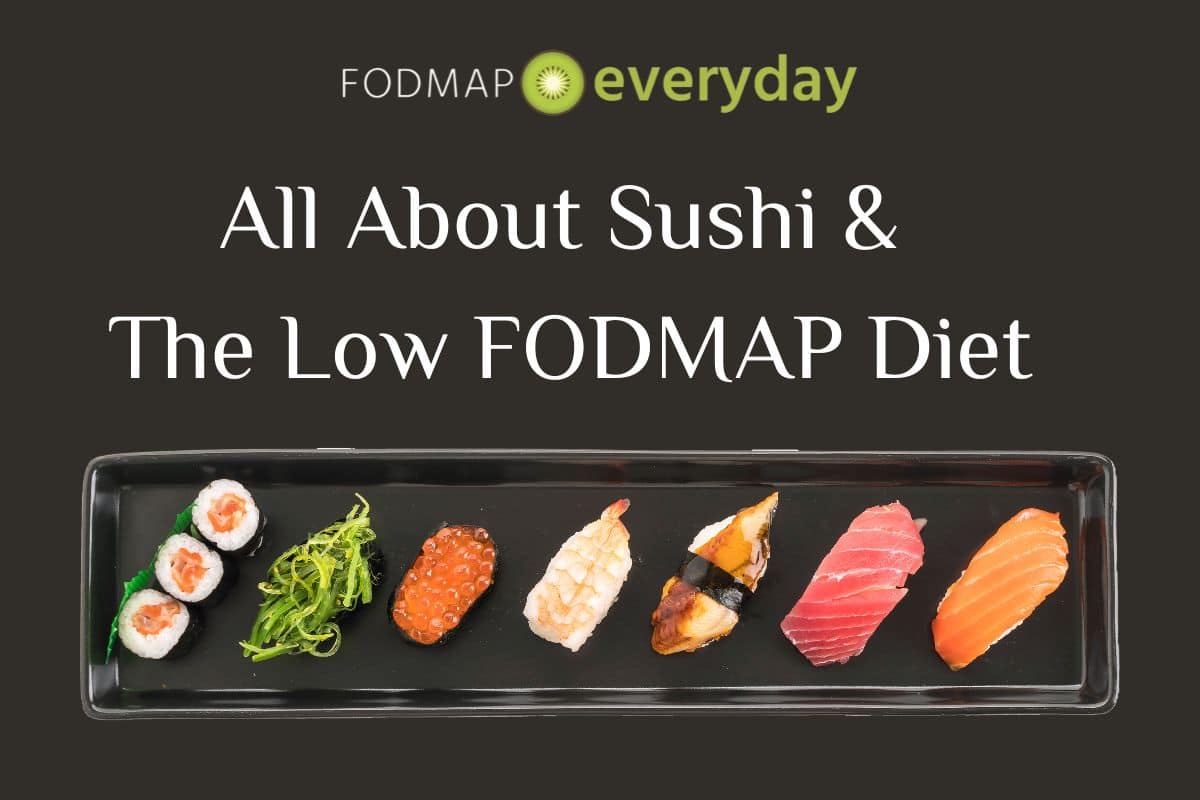
We tackle important questions, such as, should someone with irritable bowel syndrome (IBS) eat raw fish? What are the downsides? There are medical implications.
The great news is that there are many low FODMAP sushi options! We show you how to make the right choices at sushi restaurants, or when buying premade sushi.
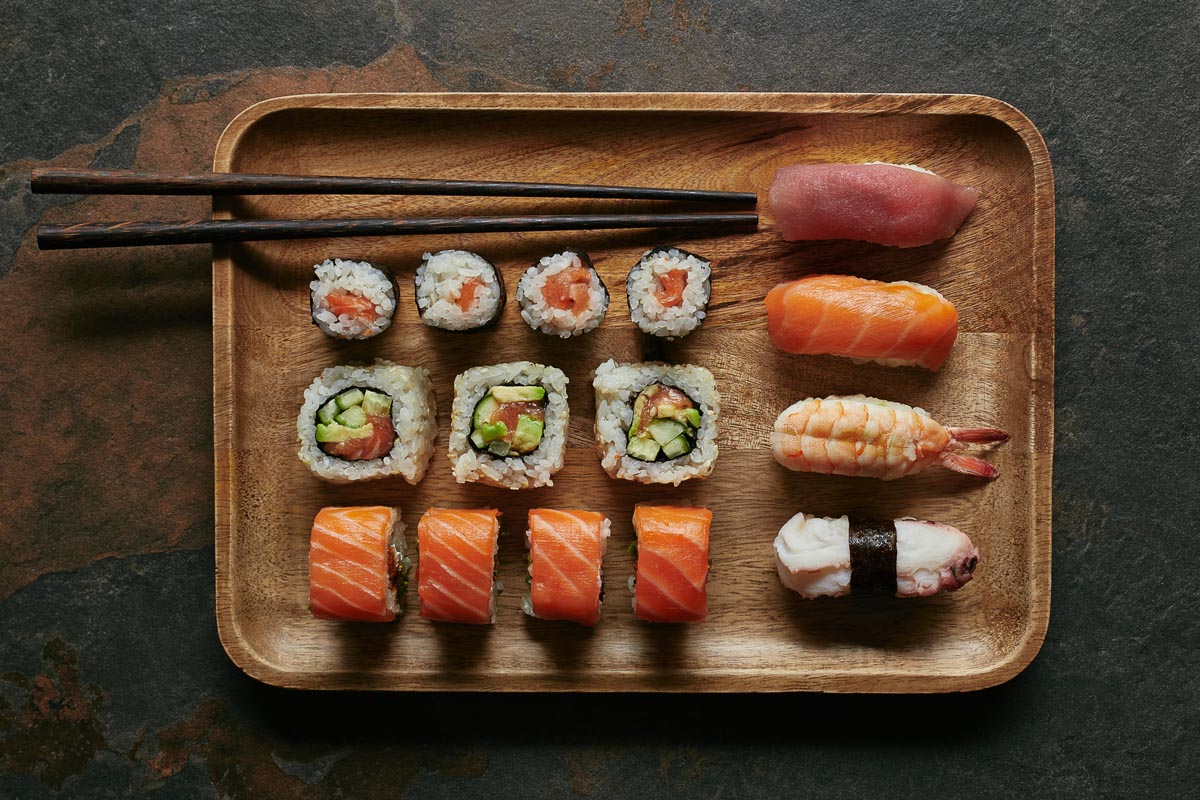
First of All, What is Sushi?

Many people think sushi is raw fish, but raw fish is correctly referred to as sashimi.
I wrote a Dummies guide to Japanese food, and the first question we addressed was “what is sushi?”, since it is so often misunderstood, especially with the American public.
According to Dictionary.com, the word “sushi” did not appear within the Japanese lexicon until 1895–1900, and literally means “it is sour”, or “sour tasting.” This is because sushi rice is flavored with vinegar. It is also sweetened with sugar and contains salt; to many palates, the sweet/sour tastes are fairly balanced, with the salty component being subtle in the background.
Sushi is vinegared rice, often in “finger-shaped” portions, that provide a base for various delectable bites, including raw fish and occasionally other ingredients such as cooked shrimp, eel, or rolled omelet. This style of sushi is known as nigirizushi. Many additional, diverse types of sushi also exist (see below), and there are plenty of low FODMAP sushi choices.
Sashimi
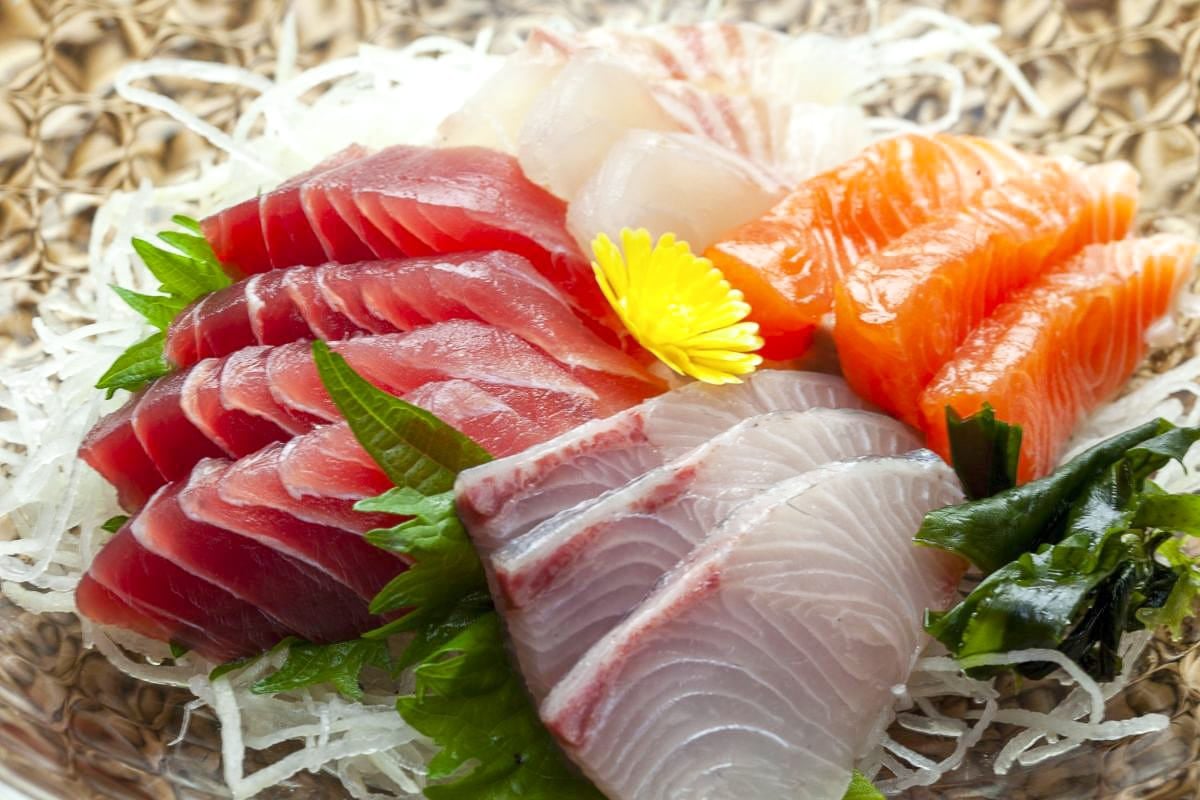
As mentioned above, sashimi is simply raw fish and as such, being pure protein, contains no FODMAPs. Enjoy as you like!
Let’s Talk Sushi Rice
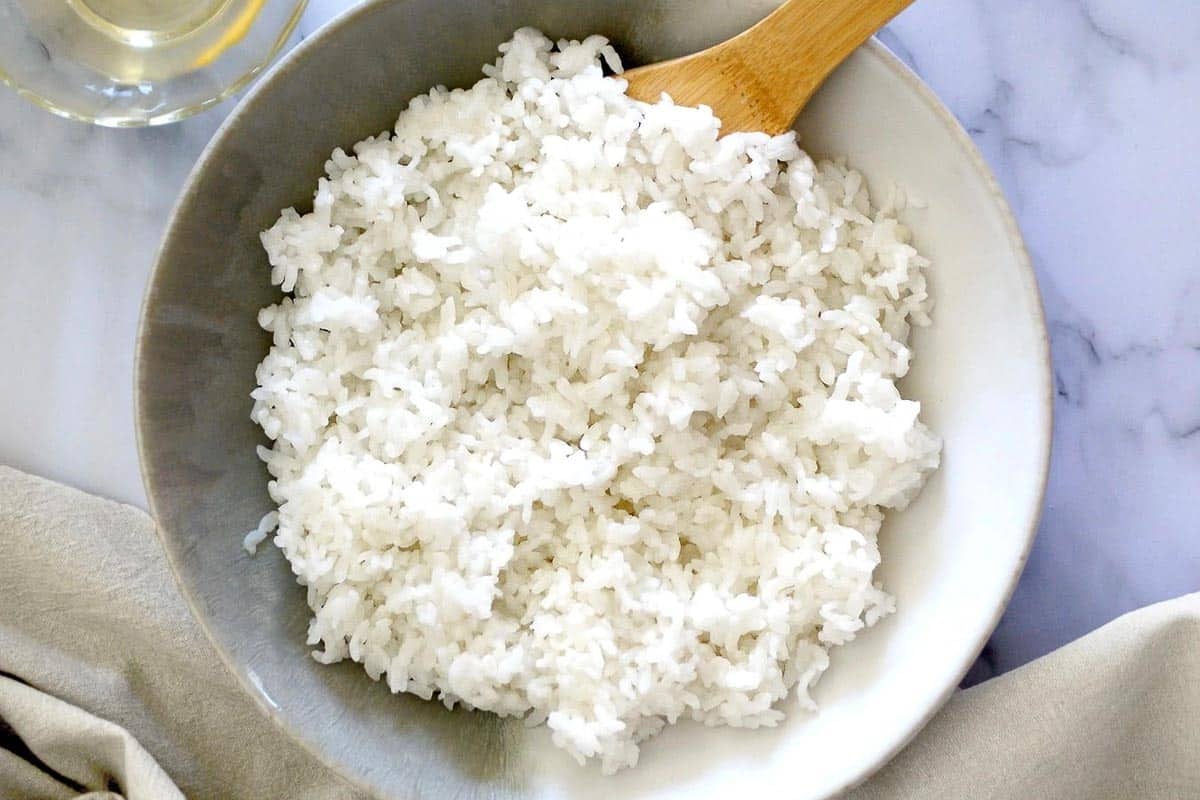
Since sushi rice will figure prominently in your sushi meal, it pays to ask questions about how the sushi rice was prepared. As explained above, sushi rice is a combination of specialized rice, water, sugar, and salt. All of those ingredients are low FODMAP. You might want to make sure that no high FODMAP high fructose corn syrup (HFCS) was used in preparing the rice.
HFCS, as you can imagine, is high in fructose, which is the “M” in FODMAP, standing for monosaccharide.
Brown Rice
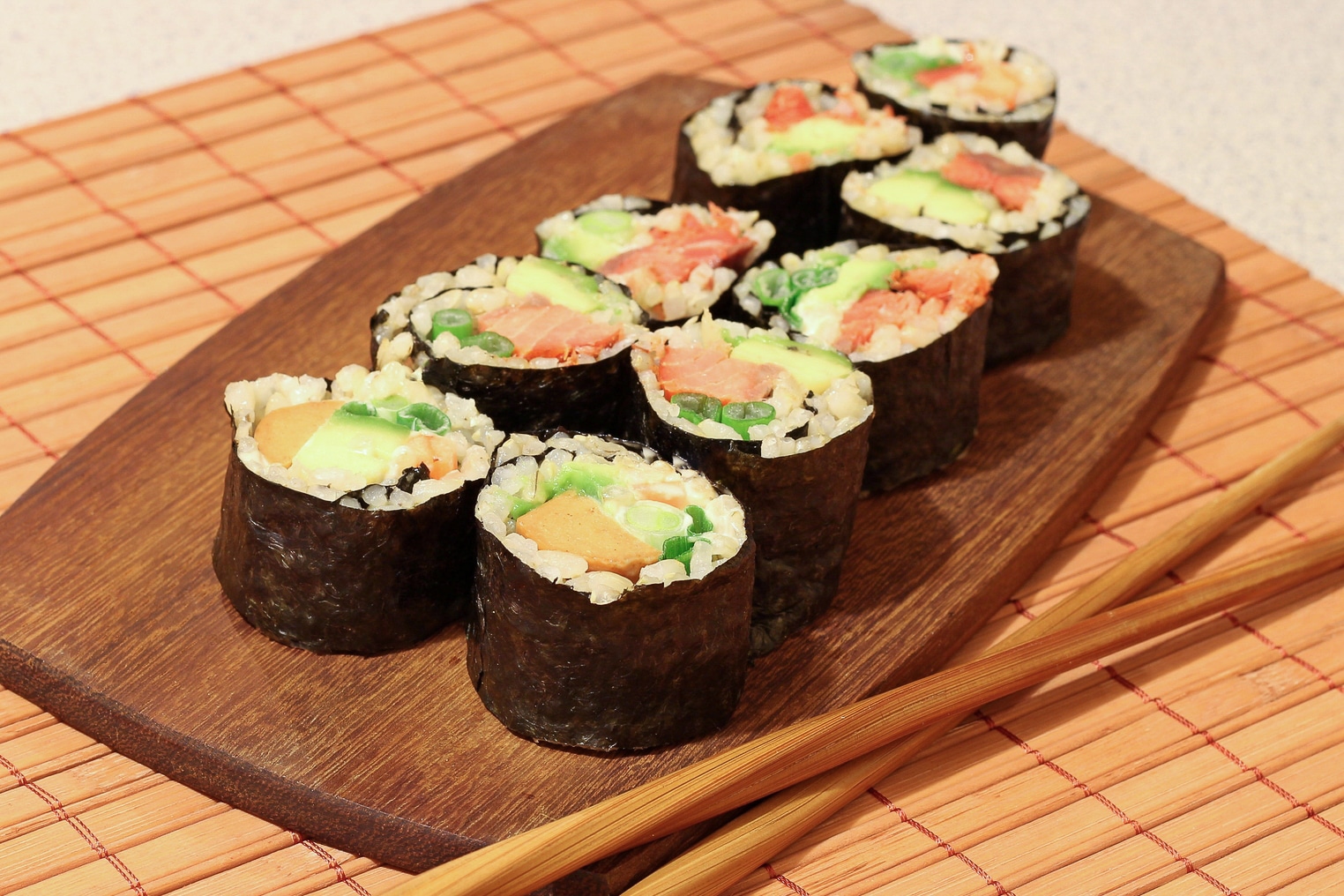
Brown rice is not traditional, but some restaurants and supermarkets offer brown rice sushi. Brown rice contains no FODMAPs, so this is a fine low FODMAP choice.
Nigirizushi – Hand-Formed Rice Portions with Toppings
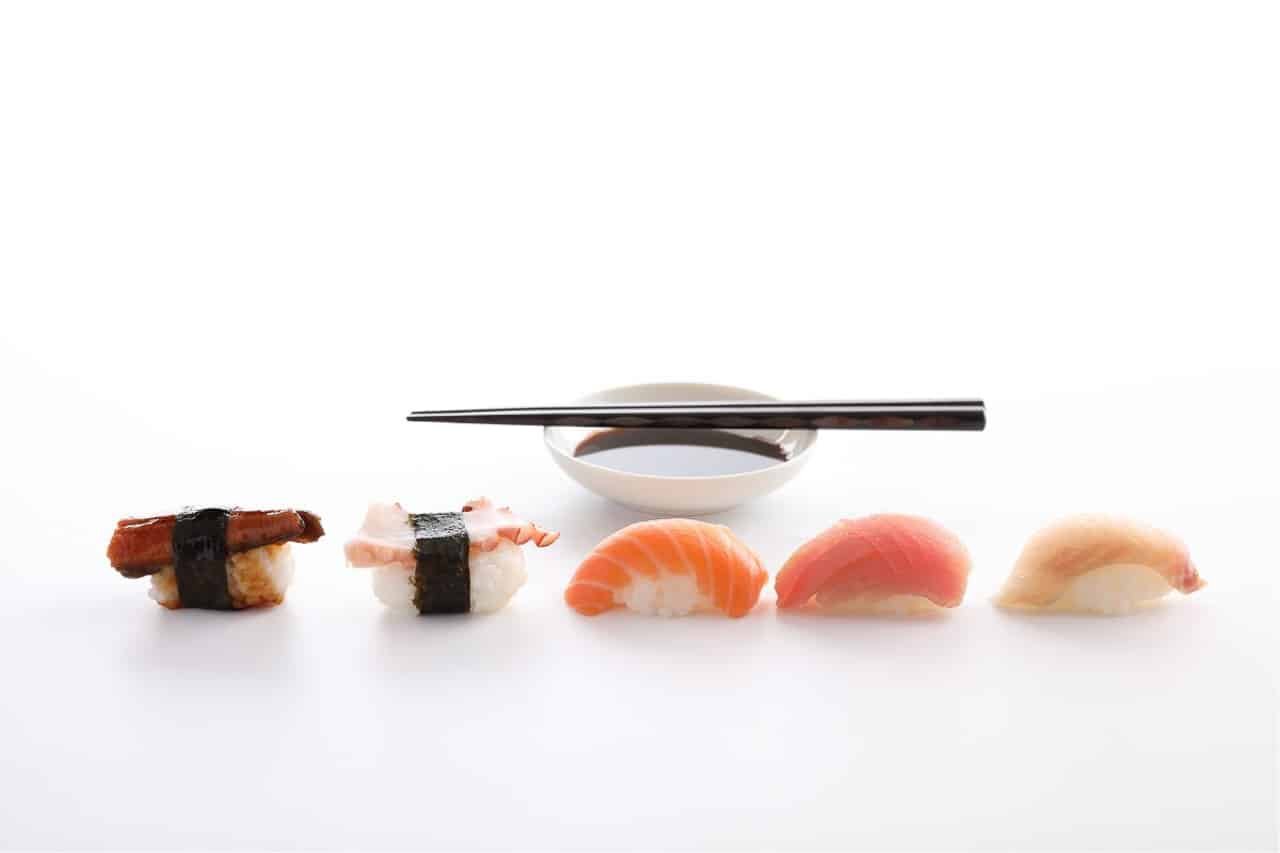
As mentioned above, this is vinegared rice fingers topped with raw fish or alternatives like cooked shrimp or sweet omelet. Raw fish is pure protein and contains no FODMAPs, therefore any of those choices would be good ones. When it comes to cooked seafood toppings, such as cooked shrimp or eel, you have to ask questions about how they were prepared (more below).
There is often a small amount of wasabi in-between the rice and the raw fish with nigirizushi. There is a low FODMAP serving of wasabi, but it will also depend on what kind of wasabi is being used (see more below).
Makizushi – Maki Rolls
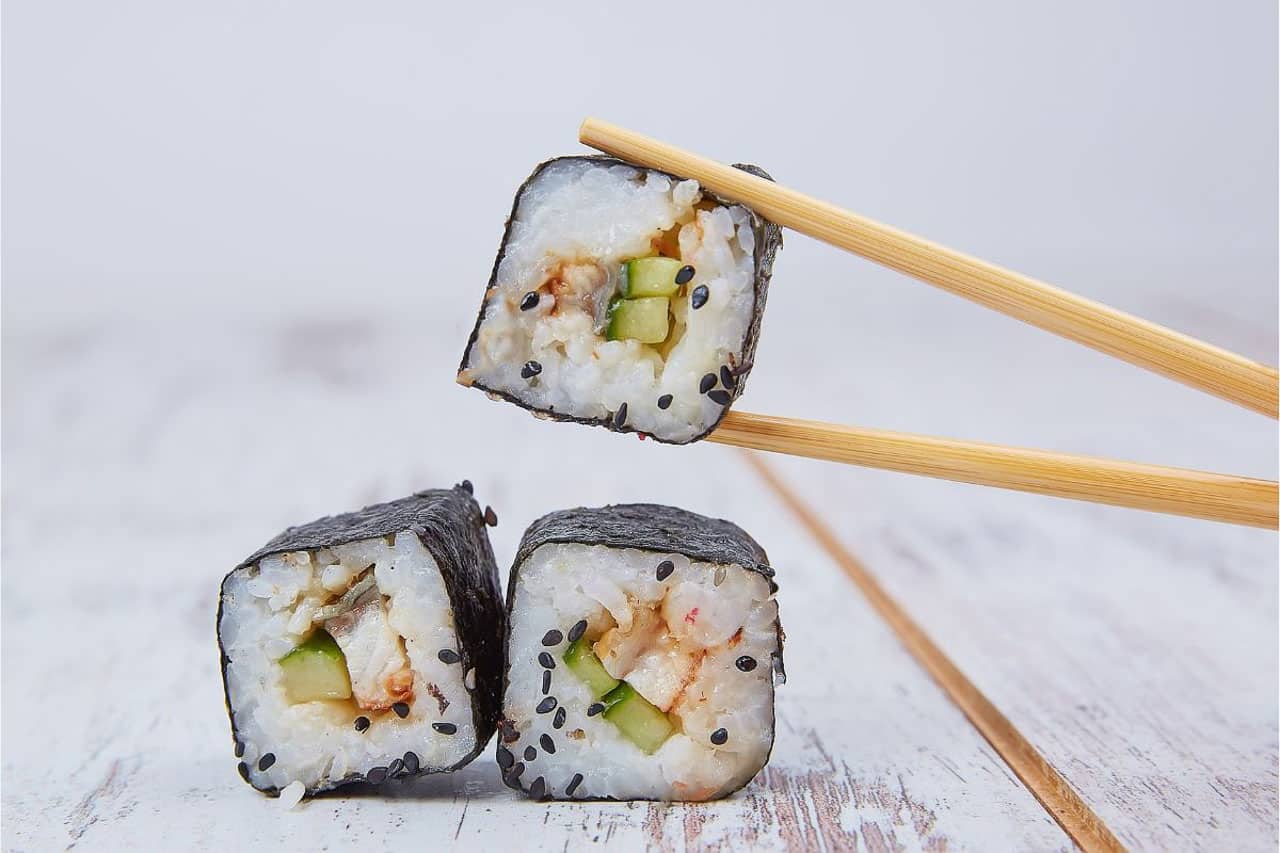
These are sushi rolls fashioned using a makisu, a bamboo mat that aids in rolling – and the finished sushi is often referred to as “maki rolls”. Typically, they involve a sheet of nori seaweed filled with sushi rice and a central filling. Some variations feature inside-out rolls, where rice envelops the exterior and nori and fillings are enclosed within. Those are called “uramaki”.
Temaki – Hand Rolls
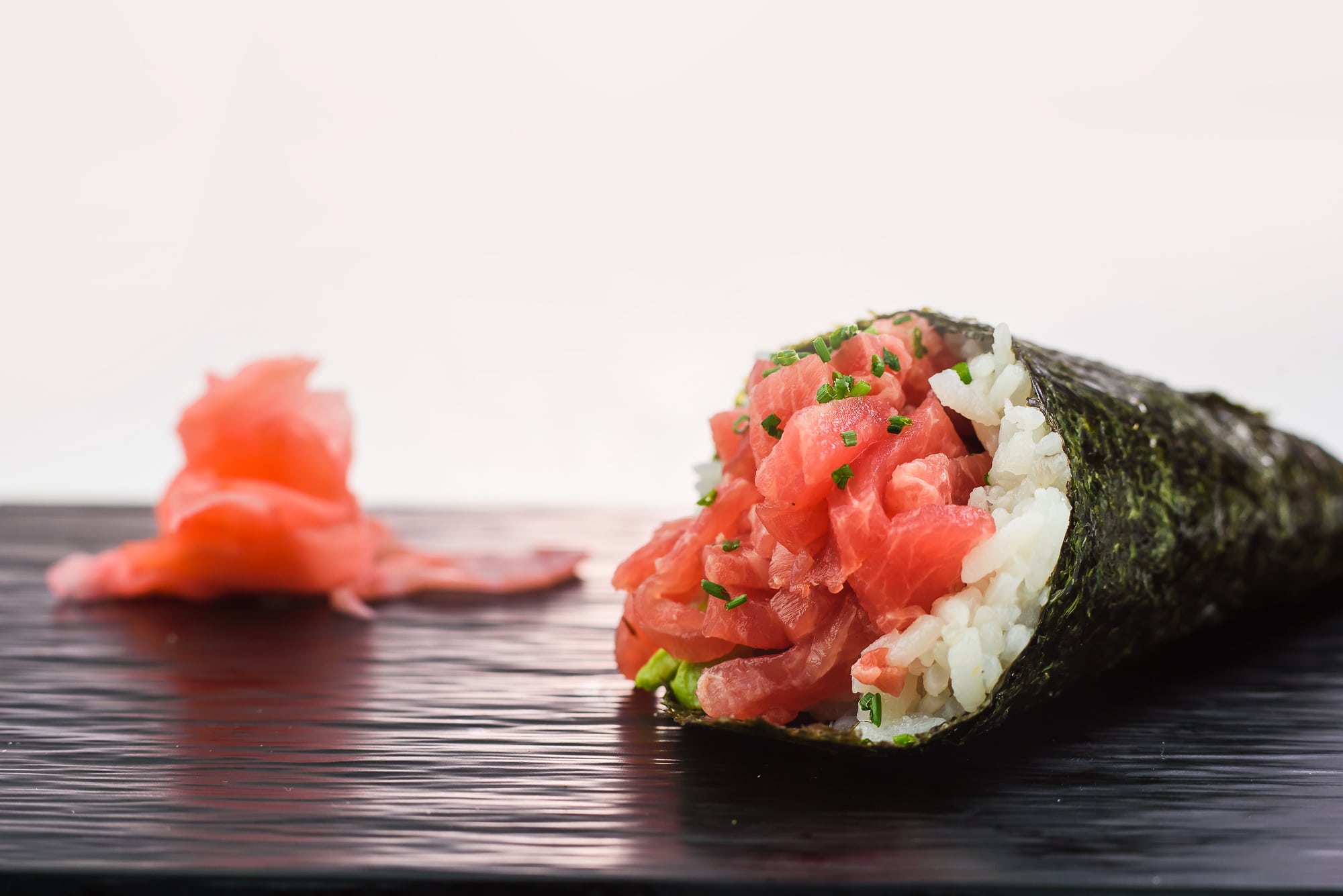
Also called “hand rolls,” temaki involves manually stuffing nori sheets with rice and fillings, creating a conical shape meant to be handheld and eaten out of hand, without chopsticks.
Oshizushi – Sushi Made with a Mold
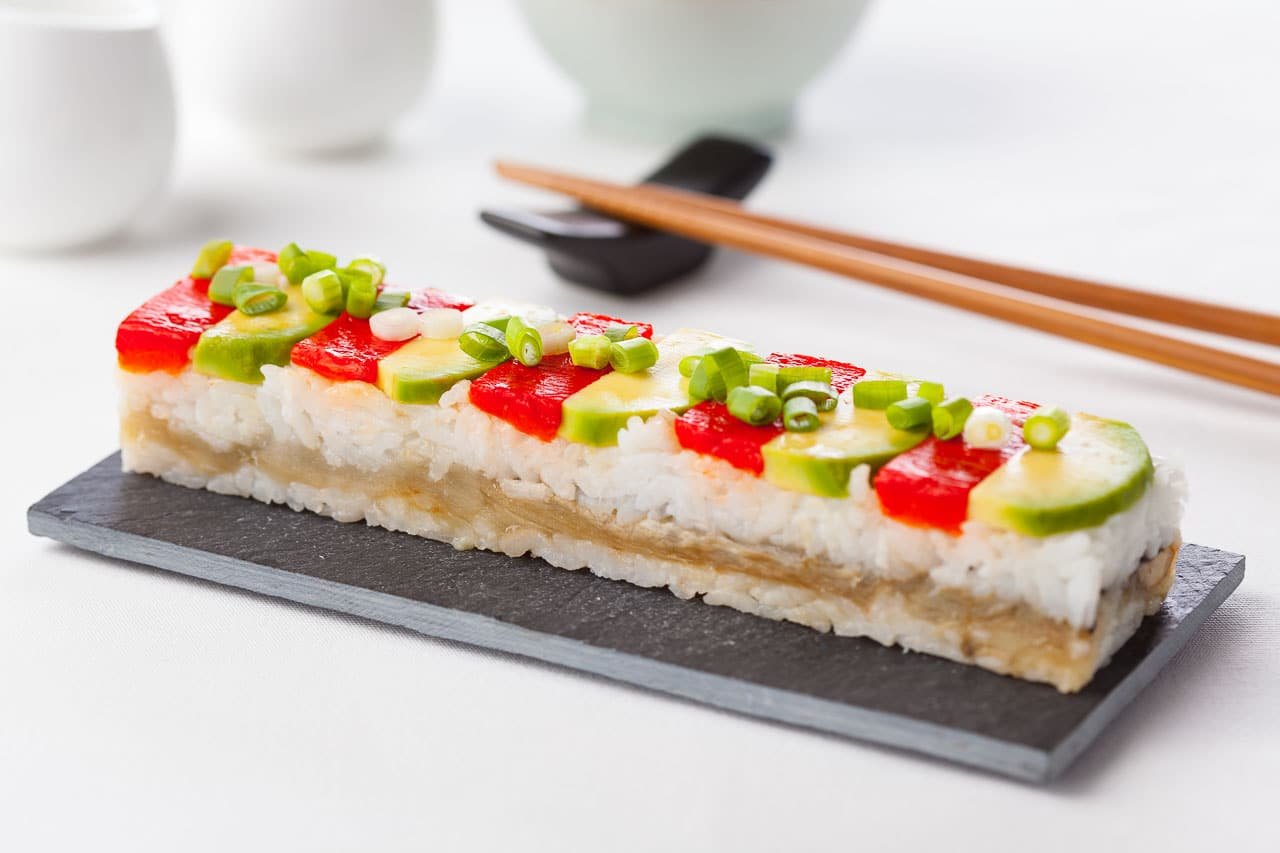
This specialty hailing from Osaka necessitates a unique mold for preparation. Sushi rice is compressed within a wooden or occasionally metal mold, then garnished with fish or toppings. The mold’s upper part is affixed, exerting pressure. Once removed, the result is a substantial sushi “cake”, subsequently sliced into bite-sized pieces. Notably, if you own one of these molds, this method offers an efficient way to craft numerous sushi pieces, making it ideal for gatherings. These molds are often available at select Asian grocery stores, and online.
Inarizushi – Rice Stuffed Fried Tofu Pouches
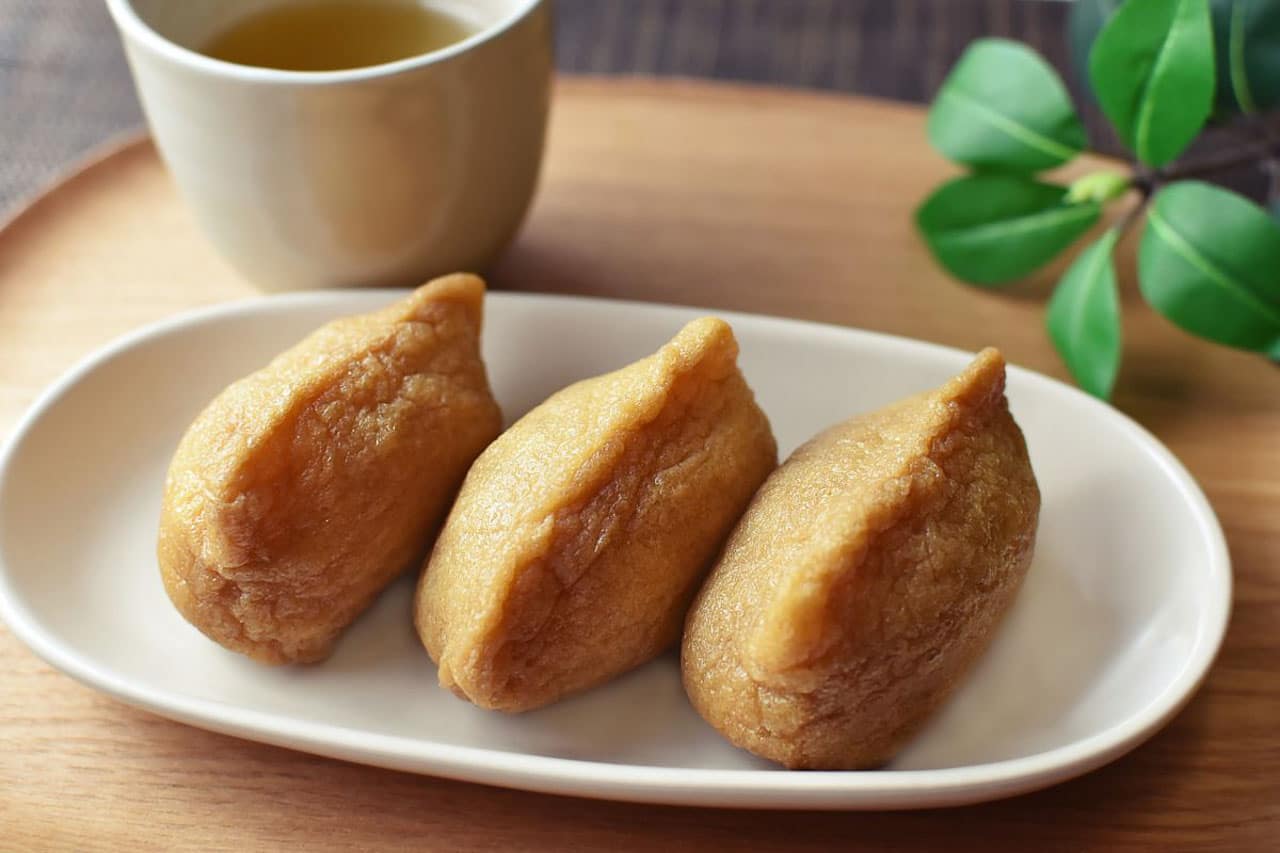
Offering a vegetarian sushi alternative, inarizushi is straightforward to assemble. You can purchase prepared “aburage”, which are fried tofu pouches, and this streamlines much of the preparation. The process involves stuffing the pouches with sushi rice and seasoning. These make for excellent additions to picnics and lunch boxes. Check the labels of the prepared aburage for high FODMAP ingredients, such as HFCS or sorbitol.
Chirashizushi – “Sushi Bowl”
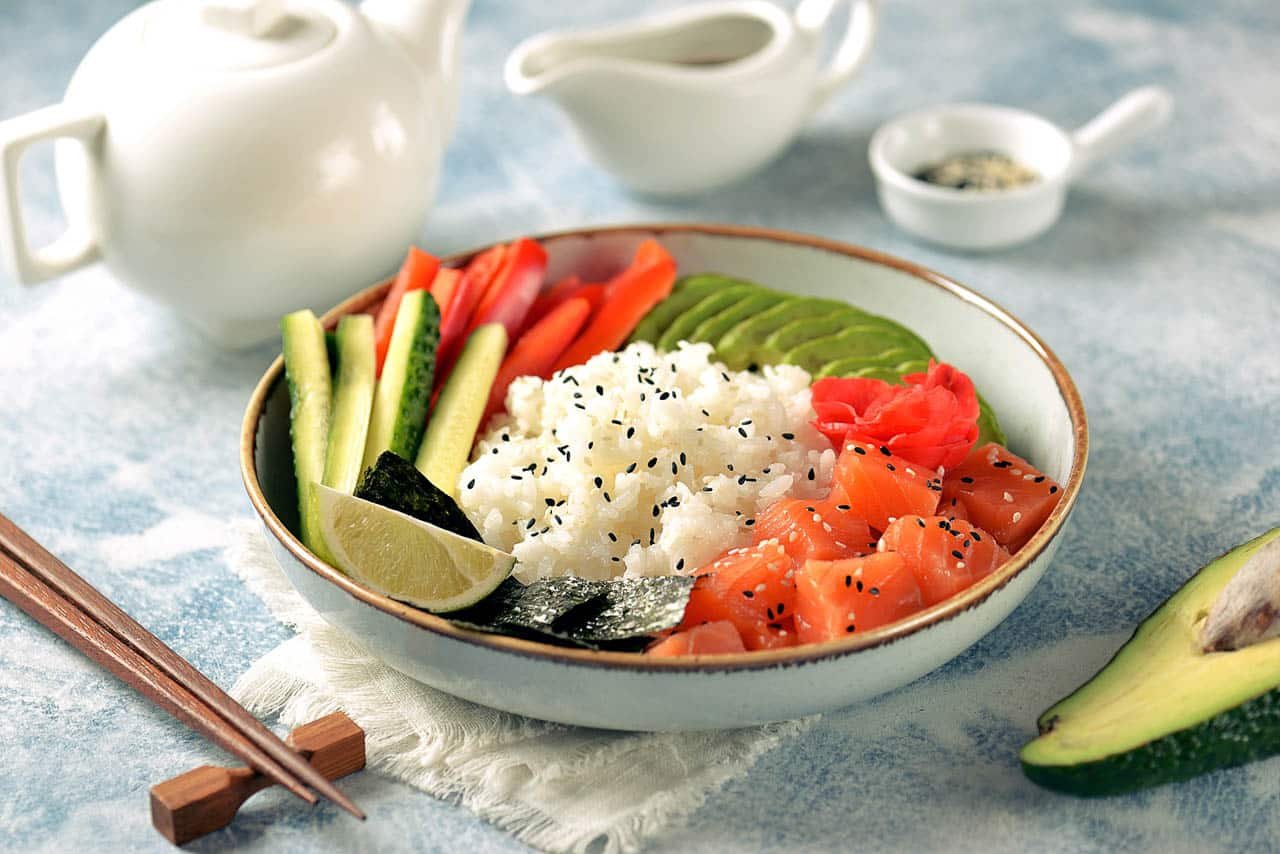
Chirashizushi translates to “scattered” sushi, accurately reflecting its nature. This sushi variation is remarkably simple: a bowl of sushi rice serves as the foundation, artfully arranged with an assortment of fish and vegetables on top. Much like oshizushi, chirashizushi is a superb choice for gatherings. It’s possible to prepare a large communal bowl for self-service or create individual portions for more intimate dinner parties.
Not All Wasabi Is The Same
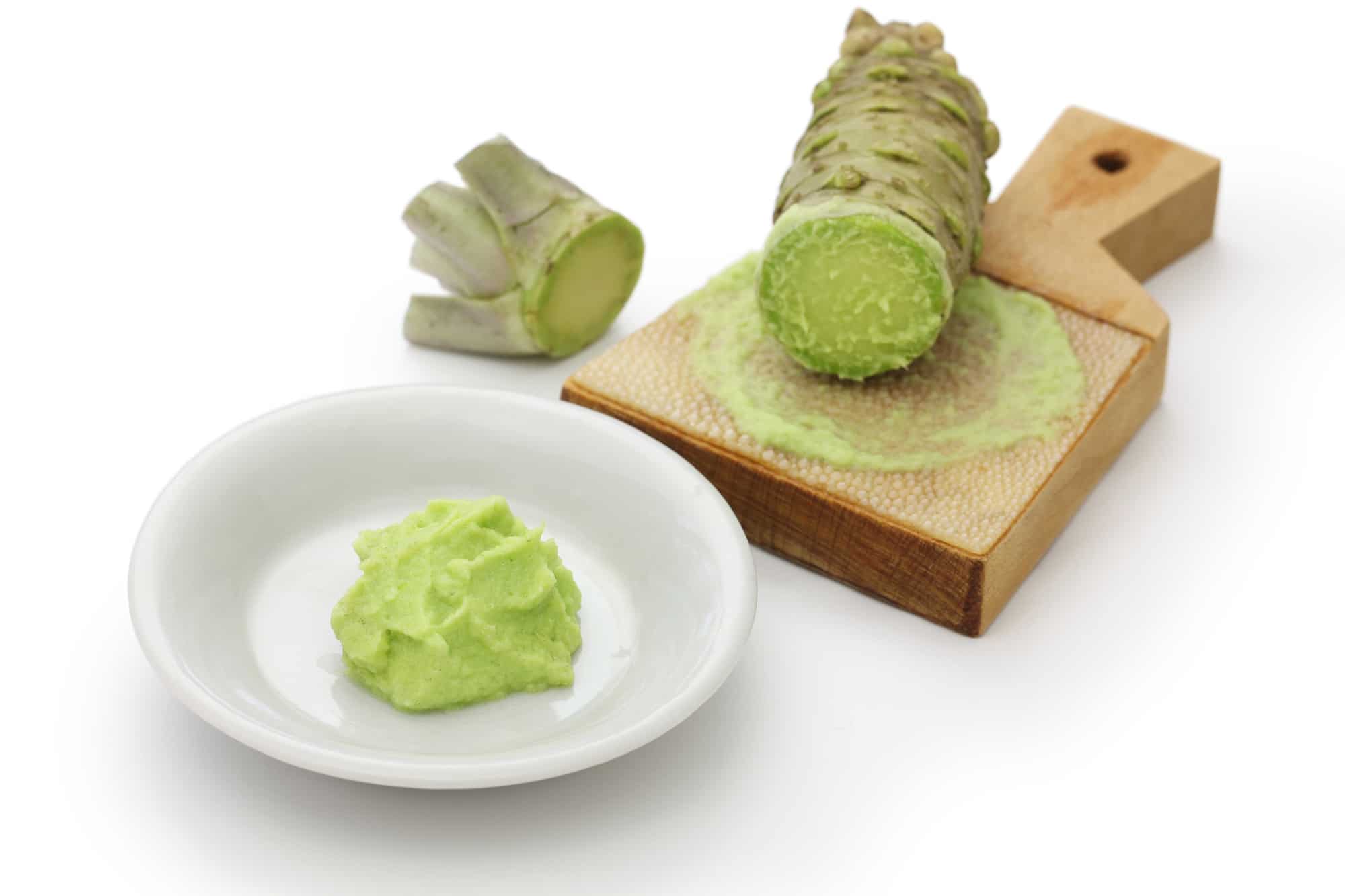
Wasabi, also known as Eutrema Japonicum or Wasabia Japonica, belongs to the same Brassica family as mustard, horseradish, turnip, and radish. It is considered to be a type of horseradish (though not the same as European horseradish) and it is the root, or rhizome, that is grated to create this beloved spicy condiment.
A traditional wasabi grater is made with sharkskin. The texture of the skin provides the perfect surface to create fresh wasabi paste, as shown above. There are modern versions made from metal.
The problem with the Monash University app is that they list wasabi powder and wasabi paste, but we do not know what ingredients were in any of the products that they lab tested. They are not all the same, so this app entry is not as helpful as it could be. Here are their findings:
- Wasabi powder (sourced in the UK) has a 1 teaspoon (5 g) low FODMAP serving size
- Wasabi paste, containing sorbitol, has a ⅛ teaspoon or 1 g low FODMAP serving size
FODMAP Friendly lab tested wasabi paste as well. We do not know if they lab tested the same brands as Monash or not, but their findings differ in serving size, and also of FODMAPs found within:
- Wasabi paste has a low FODMAP serving size of 2 tablespoons (42 g), with a max serve of 3 tablespoons (63 g). Their lab sample was high in fructans and contained zero polyols (including no sorbitol)
Please read our article on When Monash University and FODMAP Friendly Lab Test Results Differ. This is a very important article.
Neither app lists freshly grated wasabi, so you have to know what kind of wasabi you are being presented with. Some high end sushi restaurants have fresh wasabi. At any restaurant, we suggest you ask for ingredient information. You will most likely be encountering some sort of prepared wasabi paste with supermarket sushi.
FODMAPs Can Lurk Within Pickled Ginger
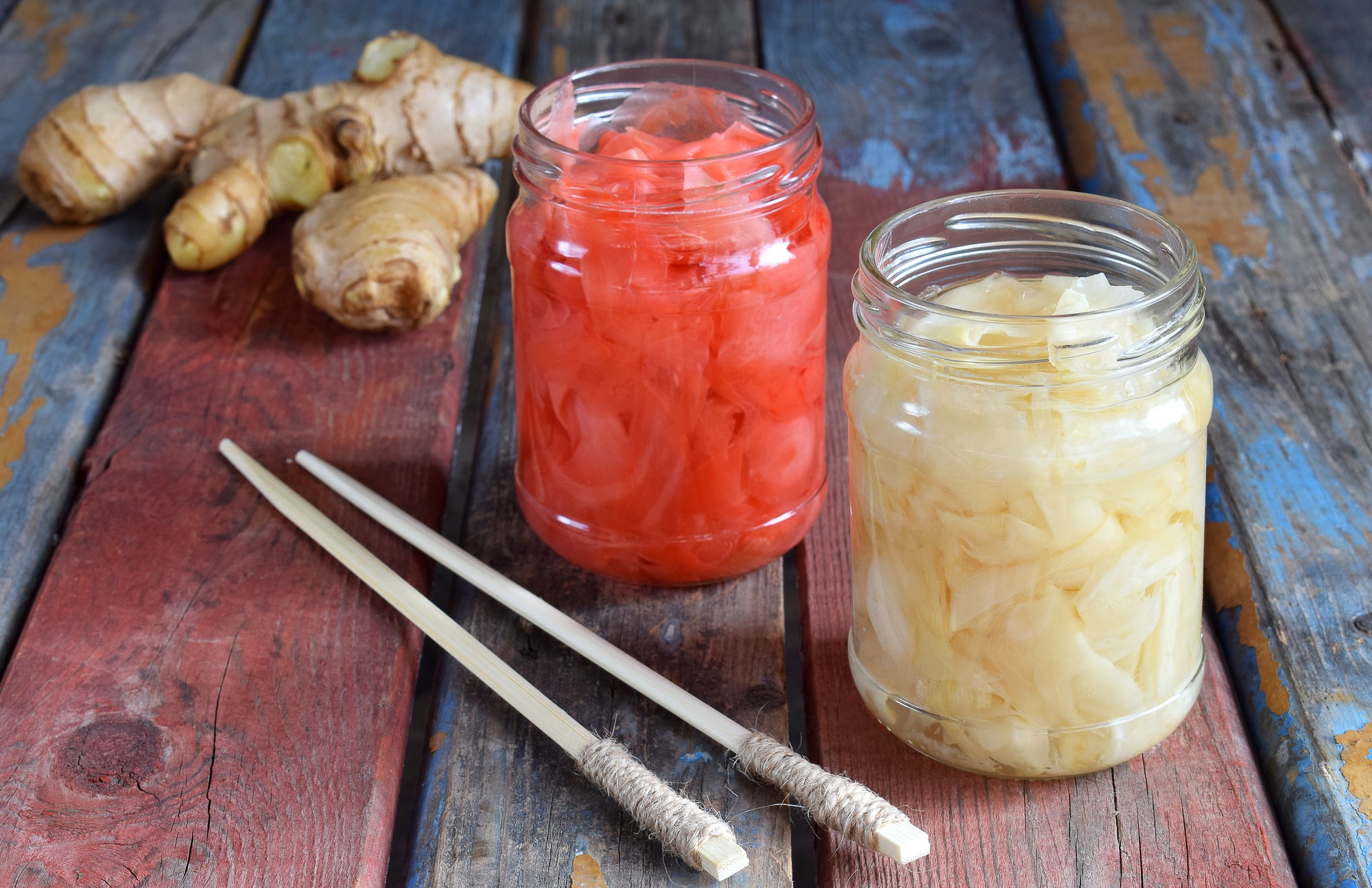
Pickled ginger is a condiment used to cleanse your palate between bites of sushi. It can be simply made with vinegar, sugar, and salt, but we do suggest that you ask about ingredients a high FODMAP ingredients can lurk, such as HFCS and sorbitol.
Some pickled ginger is dyed pink; this is not a FODMAP problem. It can be tinted pink by beet juice or shiso leaves, but it is such a small amount as to not be considered high FODMAP. In addition, pickled ginger can turn pink simply during its creation with sugar, vinegar, and salt.
Nori
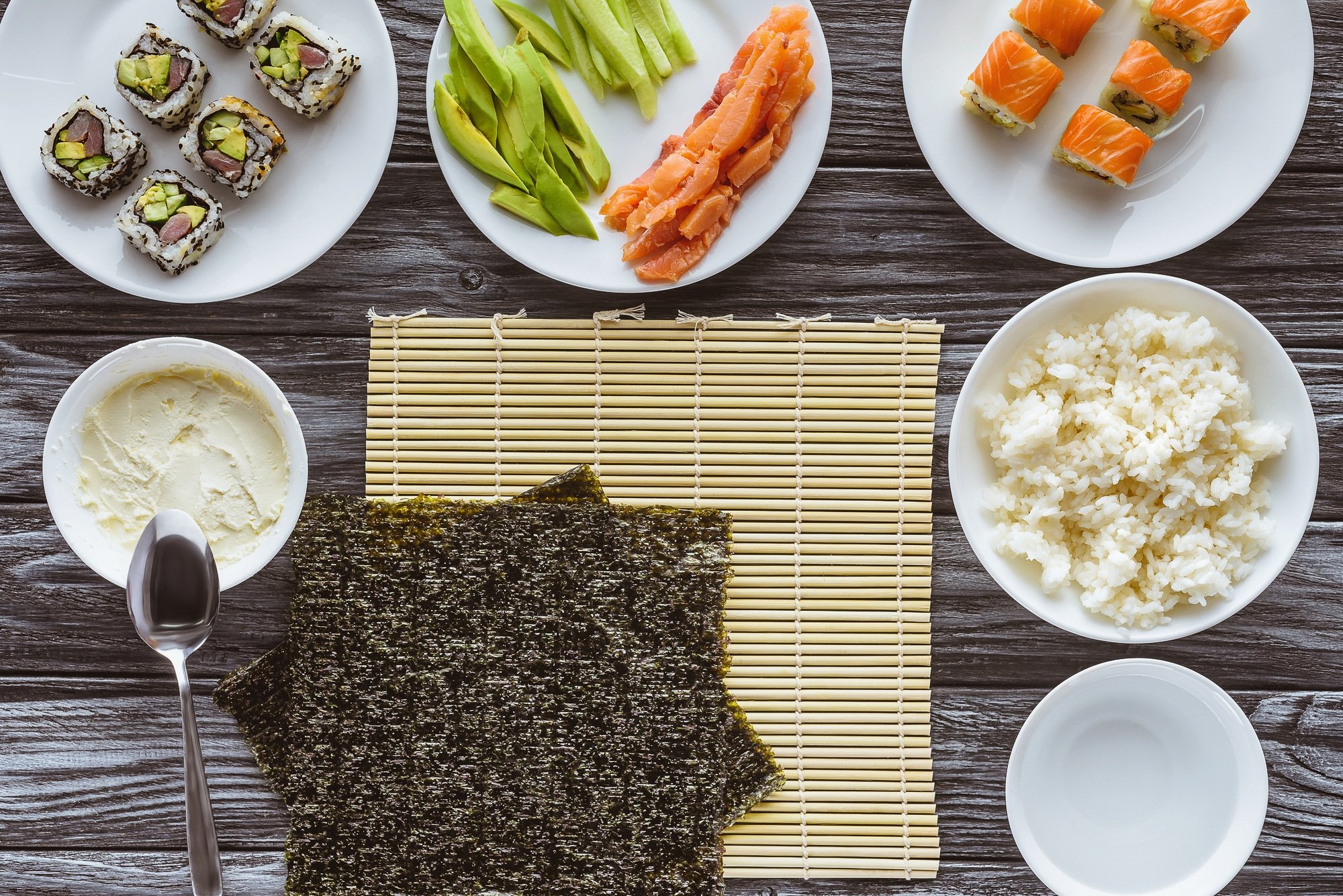
Nori is the seaweed you see wrapped around maki rolls and hand-rolls. Monash University has lab tested nori and it is low FODMAP in 5 g portions, which is “2 sheets”. This is a fairly unhelpful app entry unless you have worked with nori and know what “2 sheets” is. FYI, each sheet is about 8-inches x 7-inches (21 cm x 19 cm), and it is typical for sushi chefs to use one sheet to prepare 1 order of maki rolls. Ask to make sure.
PS: Monash does not give us Moderate yellow light or High red light FODMAP serving sizes, but they state that nori remains low up to 500 g, so consider the 5 g serving size as just a suggestion, most likely guided by Australian Healthy Eating Guidelines, and not limited by FODMAPs. You might want to review our articles, What Is A Low FODMAP Serving Size?, and also, How To Use The Monash University Low FODMAP Diet App.
Soy Sauce
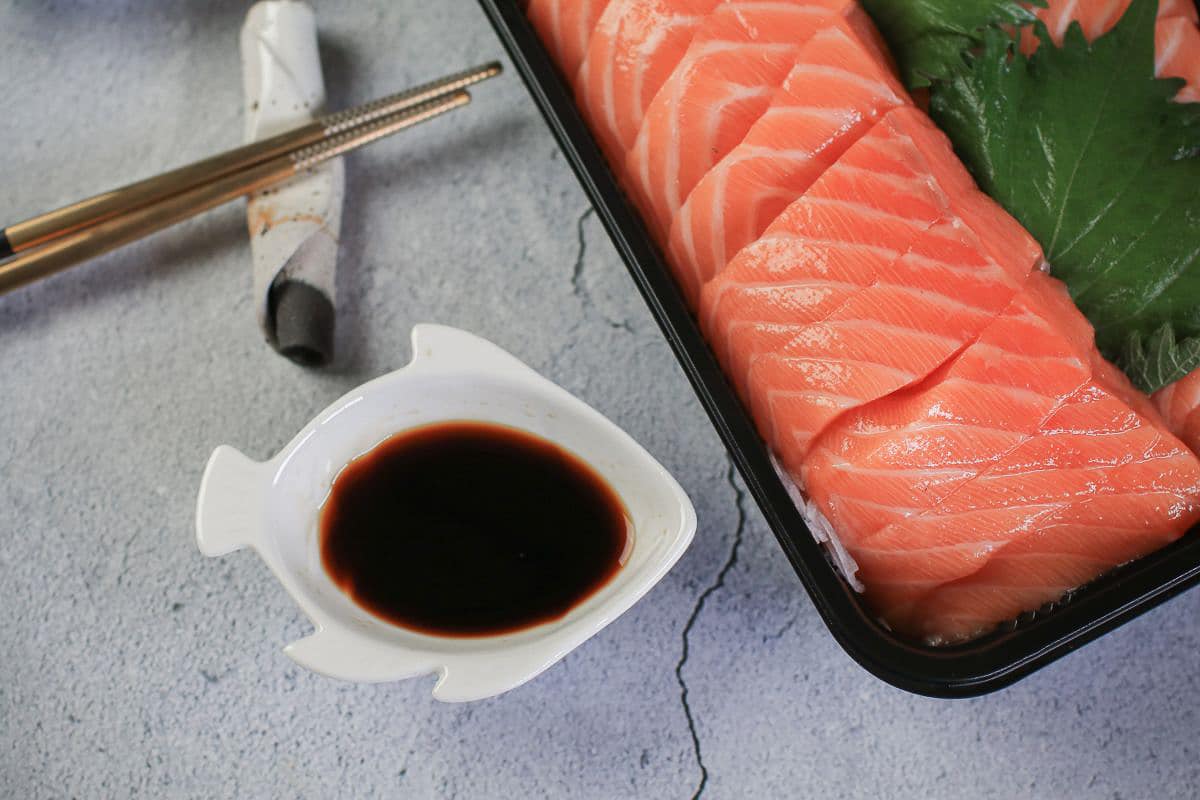
Soy sauce and tamari have low FODMAP serving sizes. Even though some soy sauce is made from wheat, it is still low FODMAP in small amounts. The low FODMAP diet is not a wheat-free (or gluten-free) diet.
We prefer low-sodium soy sauce and absolutely suggest you seek out brewed soy sauce, as opposed to chemically processed. It isn’t even like comparing apples to apples. Brewed soy sauce is complex, flavorful, and filled with umami. Chemically made soy sauce is so harsh and overly salty, that we believe it can make or break a dish. See our article, Are Soy Sauce & Tamari Low FODMAP?
Take a look at this image of side-by-side soy sauce labels, with the brewed soy sauce on the left. We are very fond of San-J low sodium, gluten-free soy sauce.
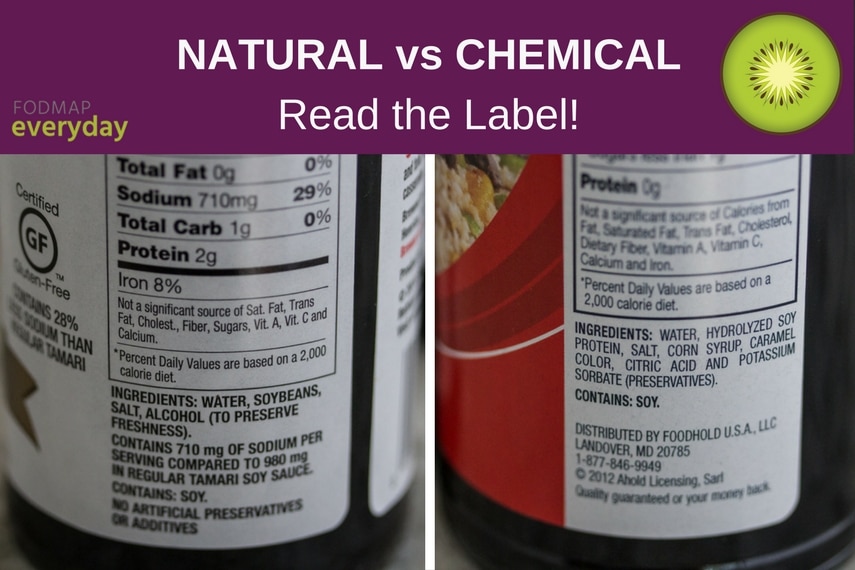
Daikon
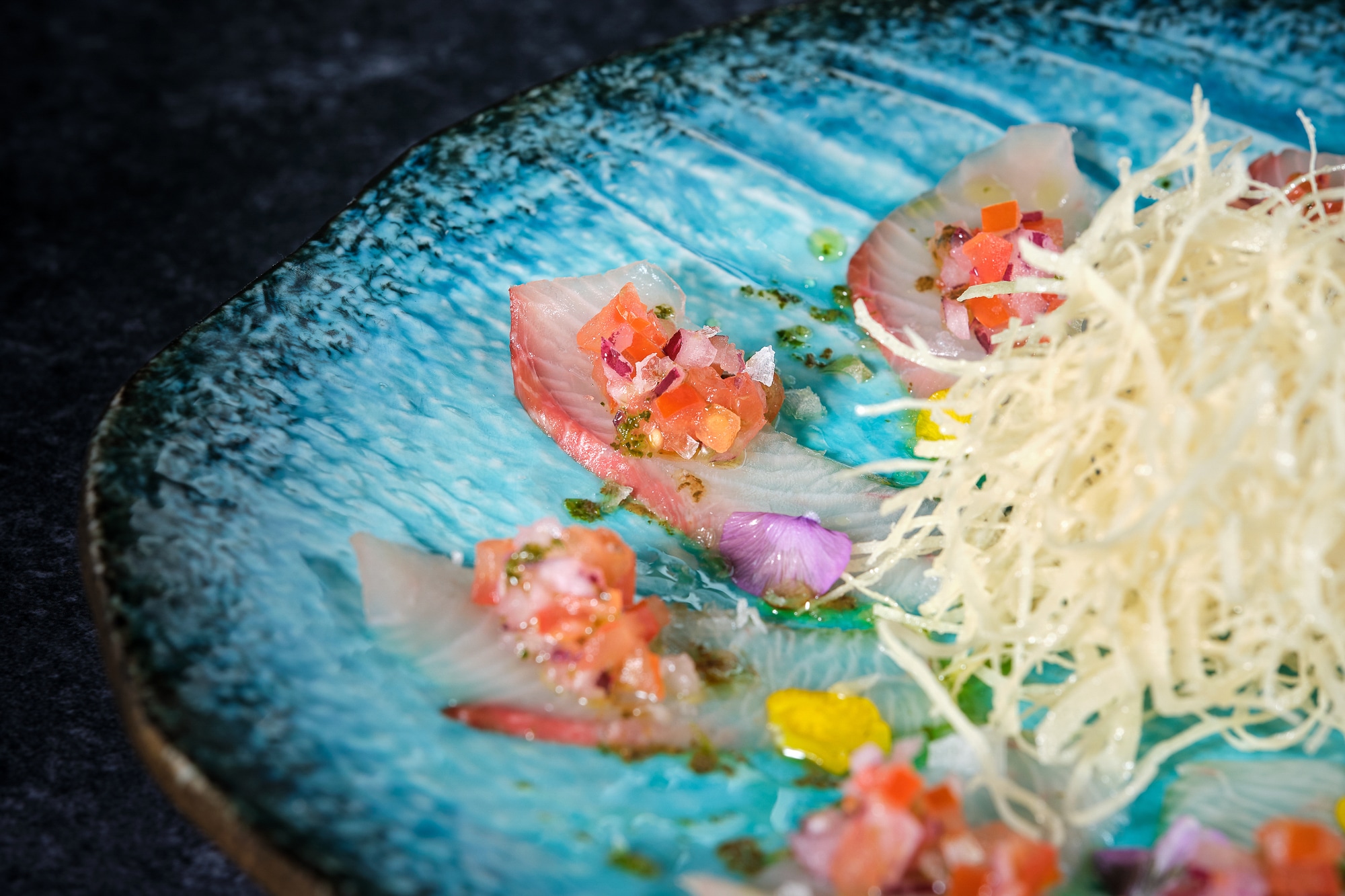
Daikon is a type of radish, and it is rather mild. You might see a mound of shredded daikon served along with your sashimi. It is meant to cleanse your palate in-between bites. Monash University las lab tested daikon and it is low FODMAP in generous 75 g (½ cup) portions. Moderate portions are 280 g (1 cup), at which point fructans register.
Additional Sauces & Condiments
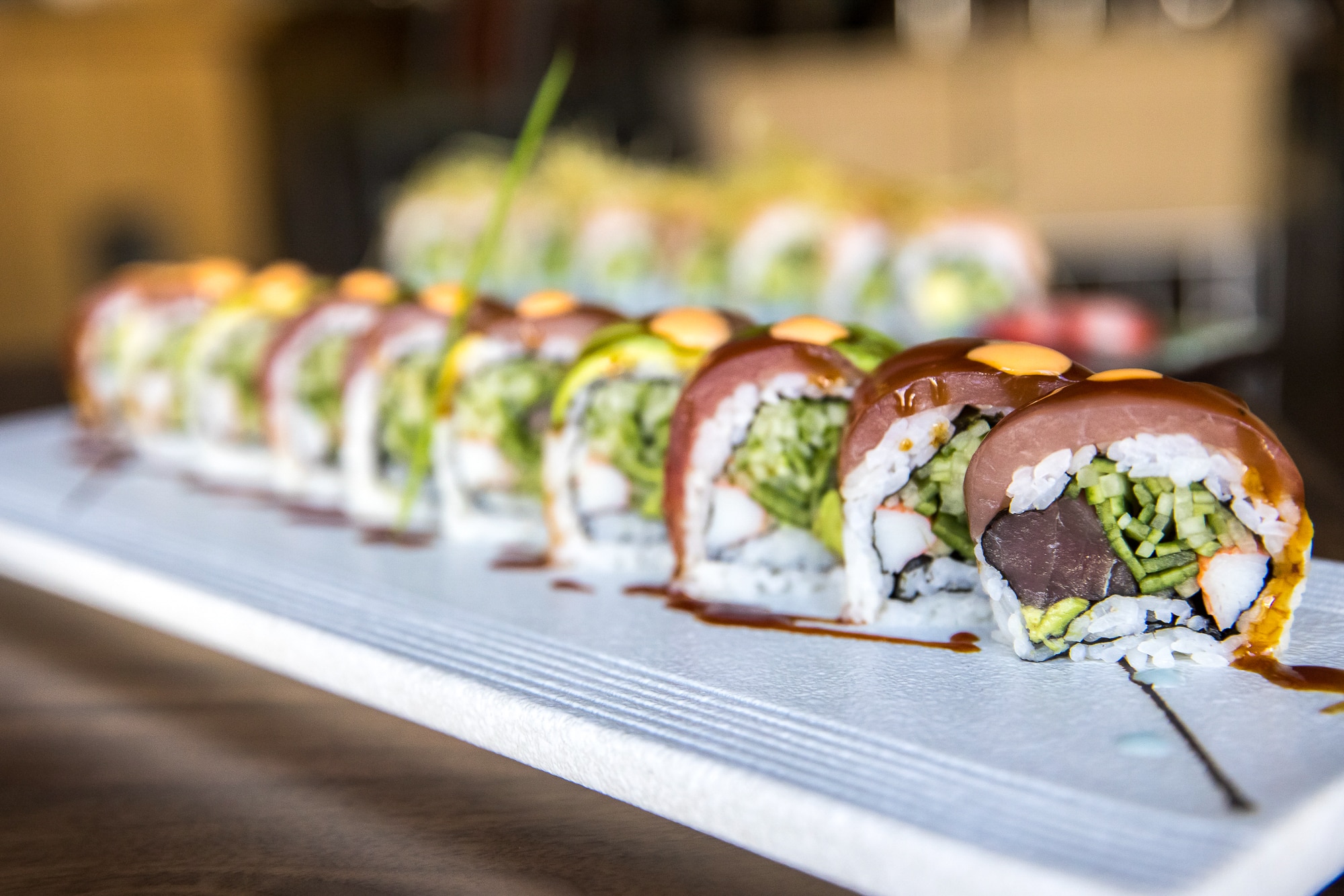
In addition to soy sauce, which will always be offered, you might come upon other sauces. Let’s look at them from a FODMAP perspective.
- Spicy Mayo: Recipes vary, but are typically comprised of mayonnaise, Sriracha, and maybe Shichimi or Nanami Togarashi. Small portions are considered low FODMAP.
- Eel Sauce: Recipes vary, but are typically comprised of soy sauce, mirin, sugar, and possibly dashi, all of which are low FODMAP. Check for high FODMAP ingredients such as HFCS and sorbitol.
- Ponzu: Recipes vary, but are typically comprised of soy sauce, sugar, citrus juice, mirin and possibly dashi. All of these ingredients have low FODMAP serving sizes. Ponzu is often offered alongside tempura, dumplings, cold noodles, sashimi, grilled meats, and other dishes. Check for high FODMAP ingredients such as HFCS and sorbitol.
- Sweet Soy Sauce: This is like an extra-thick and sweet soy sauce. Monash University has lab tested sweet soy sauce and it has a low FODMAP serving size of 1 Australian tablespoon, or 20 g.
- Yum Yum Sauce: Recipes vary, but are typically comprised of mayonnaise, ketchup, vinegar, sugar, paprika, and often garlic. There are condiments that contain garlic that have low FODMAP serving sizes, such as Sriracha and Worcestershire Sauce. Know your tolerances and proceed accordingly.
- Ginger Dressing: Recipes vary, but are typically comprised of ginger, carrots, rice vinegar, sugar, soy sauce, oil, and often a fair amount of onion. Best to avoid unless you know your fructan onion tolerance.
- Shichimi or Nanami Togarashi: These are seasoning blends consisting of hot red chile, dried orange peel, white sesame seeds, black sesame seeds, peppercorns, ginger, poppy seeds and nori. Black sesame seeds have not been reported on in the smartphone apps, but they have appeared in prepared foods that have been deemed low FODMAP. These blends are considered low FODMAP, especially since you will not be eating much.
- MSG: Monosodium glutamate has gotten a bad rap. It is not a FODMAP problem, nor has it been proven to be a dietary issue in general. Our article on Umami explains more.
Low FODMAP Sushi & Japanese Restaurant Choices
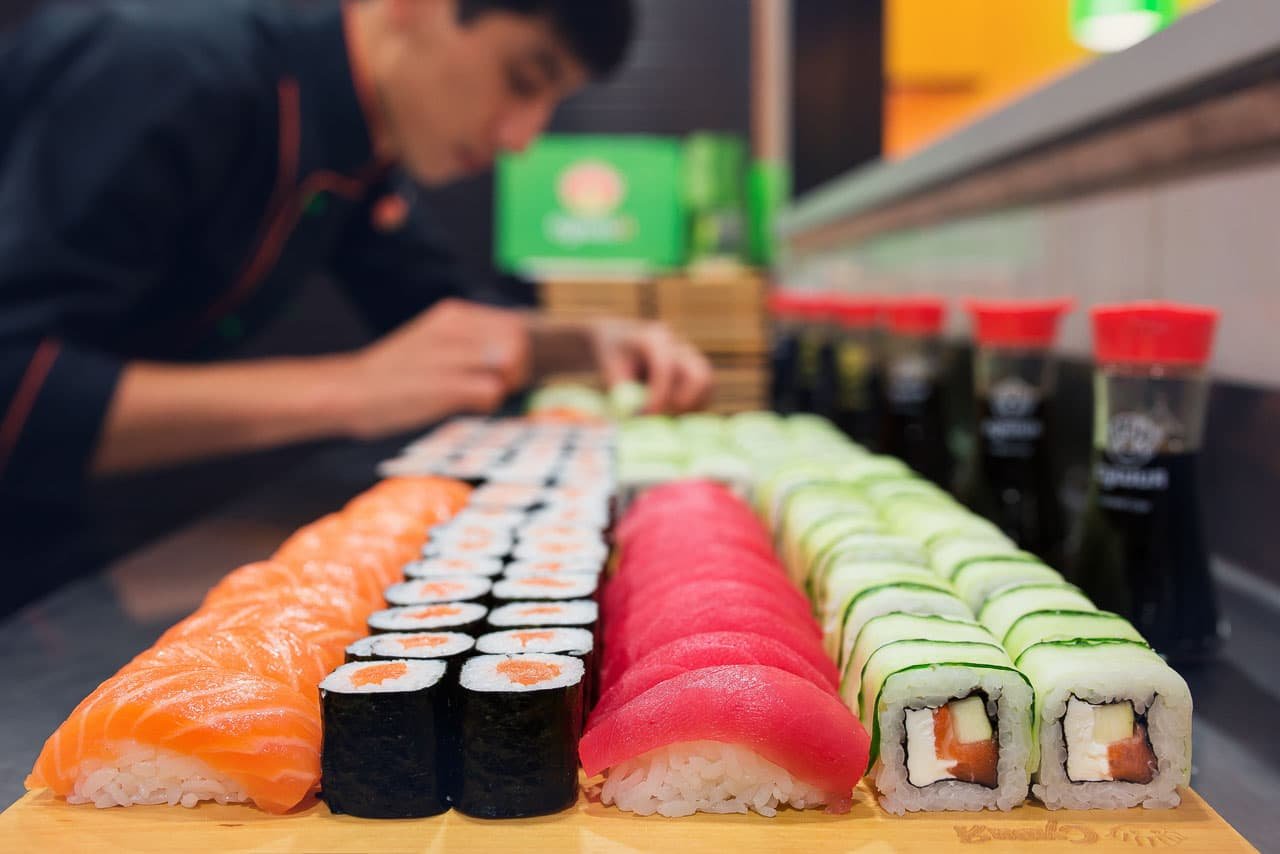
While the following list is not complete, it offers guidance for what to order at a sushi restaurant, including more than sushi! For instance, you might start off with a bowl of miso soup. Always refer to your Monash University and FODMAP Friendly smartphone apps for specific serving sizes.
- Raw Fish: All fish and shellfish are pure protein, and if served raw, contain no FODMAPs. This would include salmon (sake), tuna (maguro/toro/chu-toro), yellowtail (buri), flounder (hirame), red snapper (tai), scallops (hotate), sea urchin (uni), and mackerel (saba), all of which are fairly common and popular.
- Cooked Fish & Shellfish: These choices can be low FODMAP, depending on how they are cooked. Shrimp (ebi), octopus (tako), and squid (ika) are often simply blanched or steamed and would be low FODMAP. Salmon or tuna can be briefly seared. Ask about ingredients and preparation, if in doubt.
- Smoked Salmon: Smoked salmon is low FODMAP and found on some sushi menus.
- Cooked Eel (unagi): You can find different kinds of eel on sushi menus, but the most common is BBQ eel; look for “unagi” on the menu. The eel is basted in a sauce, known as tare, or “unagi sauce”, and you do have to ask about the ingredients of the tare used. Some is low FODMAP, some is not. Watch out for HFCS. Tare is like a thicker, sweeter version of teriyaki.
- Fish Roe (tobiko): All fish eggs are low FODMAP.
- Japanese Rolled Omelet (tamago) makes a great low FODMAP topping for nigirizushi and other kinds of sushi.
- Avocado can be enjoyed on the low FODMAP diet. The conservative approach would be to follow Monash University’s recommendations of 60 g per serving. FODMAP Friendly lab testing suggests that you may “eat freely”. Read more in our article, Is Avocado Low FODMAP?
- Cucumbers are used in many makizushi and are low FODMAP/no FODMAP.
- Sweet Potato: Generous portions are low FODMAP.
- Surimi – aka Imitation Crab: Fake crab (also called kamaboko, crab sticks or Krab) is used to make the very popular California Roll. Some surimi is low FODMAP, while other brands contain polyols (it would usually be sorbitol) or HFCS. Ask your waitperson. There might also be natural flavors, which would have to be checked with the manufacturer.
- Tempura: Shrimp tempura is a popular maki roll filling. Typically, it is made with a wheat coating. Small amounts of wheat are low FODMAP. Just know your own tolerance to fructans and gluten in wheat. You could try it inside a roll, but we do not suggest that you order an entire main dish of tempura itself.
- Teriyaki: Anything labeled as “teriyaki” could very well contain high FODMAP ingredients such as onion and garlic. Inquire with your server; if in doubt, do not order.
- Miso soup: Miso is often brought to the table as a starter (or offered à la carte) and miso does have low FODMAP serving sizes. Just be mindful of any additional ingredients. Read more in our article, Soy Products: Low FODMAP or Not?
- Seaweed salad: Certainly not all seaweed salad recipes are the same, but in the U.S., there is a common preparation found in supermarkets and restaurants. It is often made with wakame seaweed, which Monash has lab tested and the serving size is quite small – 5 g, or 1 teaspoon! And it becomes Moderate for FODMAPs at 2 teaspoons or 10 g. Best to avoid unless you do well with mannitol, which is the FODMAP wakame contains.
- Edamame: Edamame are immature soybeans and do not have the same FODMAP profile as mature soybeans, which are high FODMAP when dried and made into flour, for instance. Monash University has lab tested frozen, shelled, edamame and they are low FODMAP in 90 g (½ cup) amounts (that’s for shelled; that is a lot!); they become Moderate for FODMAPs at 210 g.
Popular Sushi Rolls
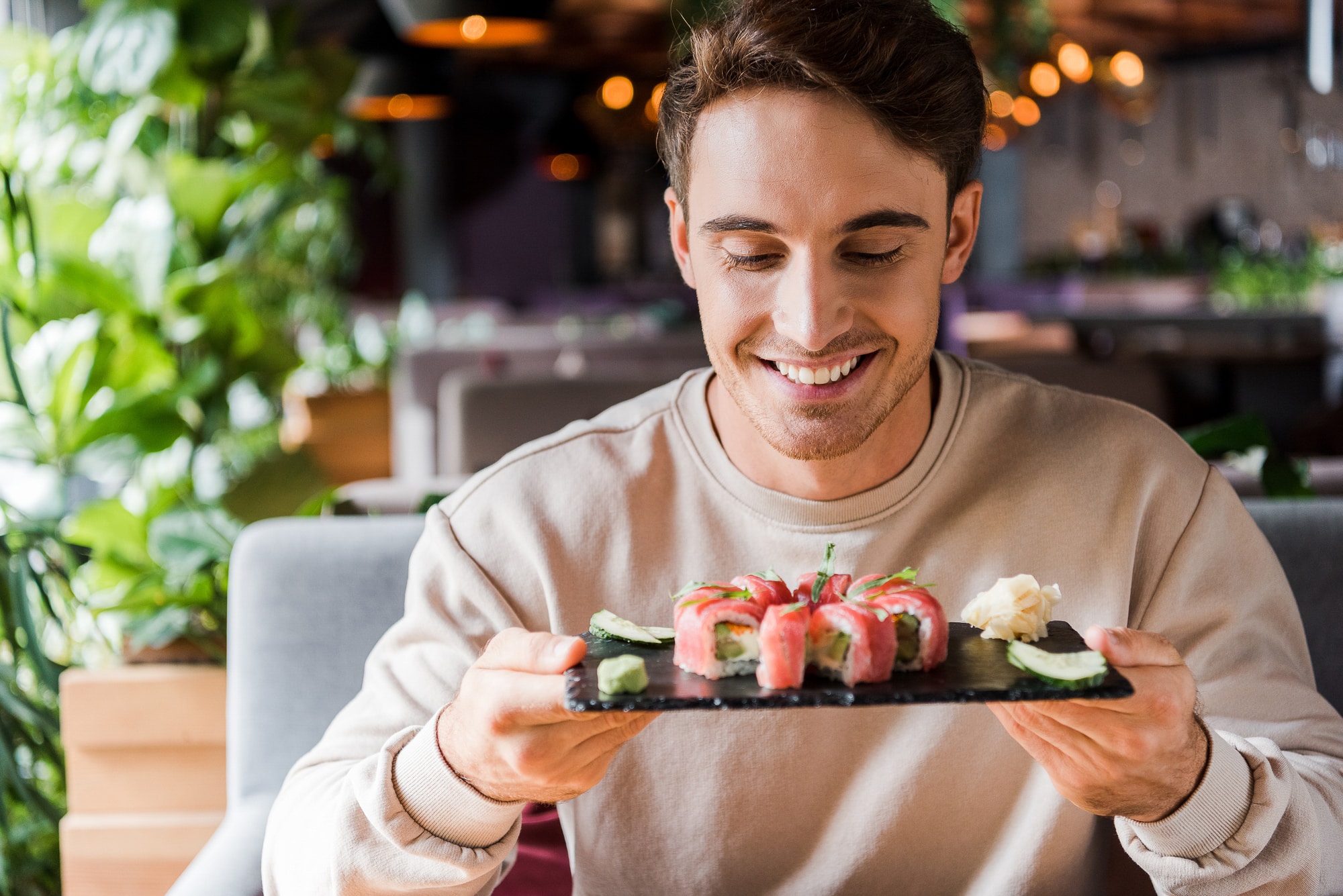
Here are some popular sushi rolls, with some serving size guidance. Note that rolls of the same name can vary, depending on who is making them. Ask whether wasabi has already been added to your rolls and take that into consideration; you cannot usually see it.
- California Roll
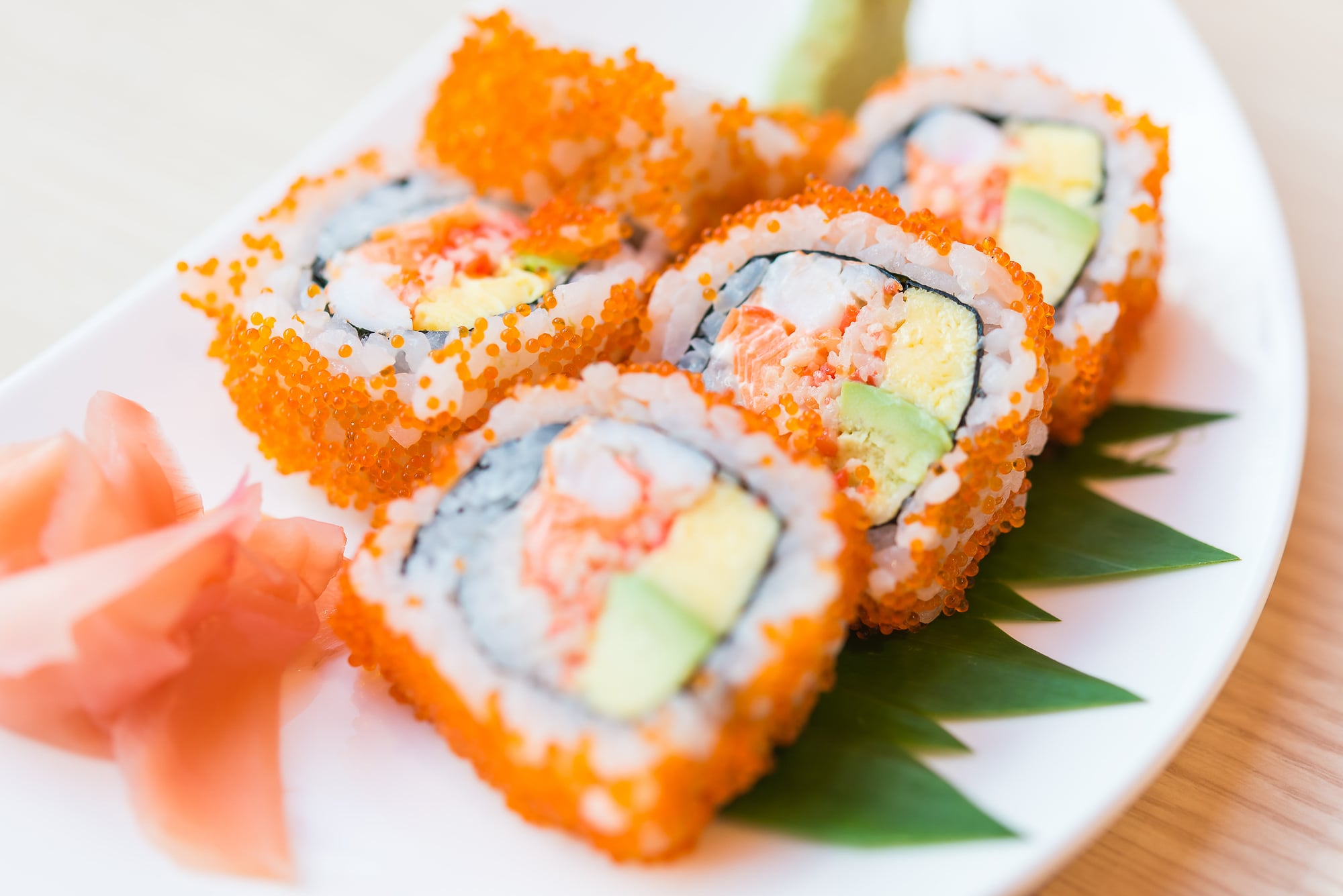
Surimi, avocado and cucumber along with rice and nori. Fish eggs sometimes coat the exterior. Surimi, avocado and nori would be the limiting factors from a FODMAP perspective.
- Caterpillar Roll: Cooked eel and avocado, in addition to rice and nori. The eel, eel sauce, avocado and nori would be the limiting factors from a FODMAP perspective.
- Dragon Roll: Features shrimp tempura, avocado, eel sauce, nori and rice and is often garnished with sesame seeds. The tempura batter, avocado, eel sauce and nori would be the limiting factors from a FODMAP perspective.
- Rainbow Roll:
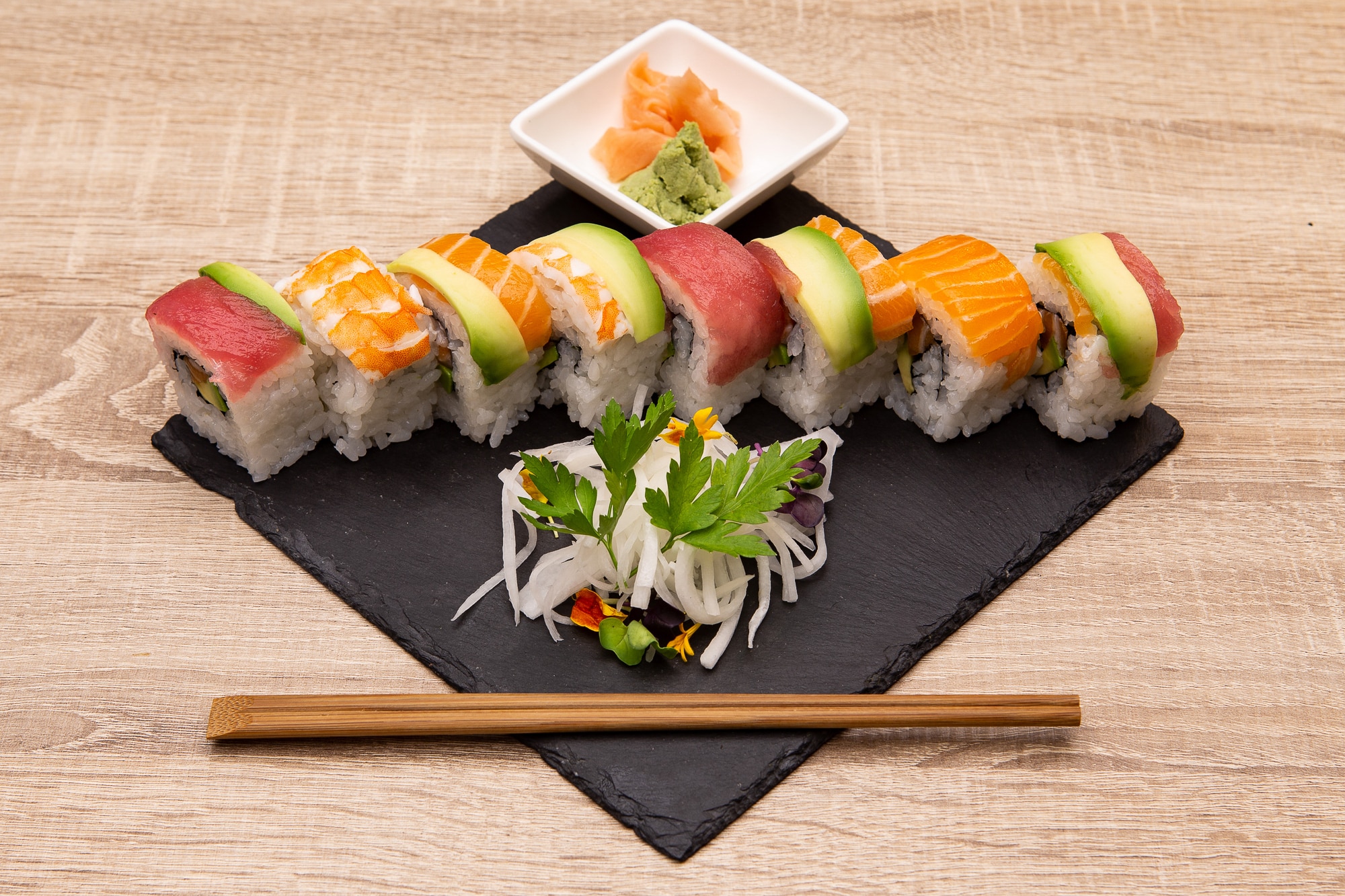
This inside-out (uramaki) roll is quite colorful, hence its name, typically being comprised of tuna, salmon, and avocado, along with rice and nori (the one in the image used shrimp, as well). Sometimes there is surimi inside. The nori, avocado and surimi would be the limiting factors from a FODMAP perspective.
- Philadelphia Roll: Smoked salmon, cream cheese and cucumber, in addition to rice and nori. The cream cheese and nori would be the limiting factors from a FODMAP perspective.
- Spicy Tuna Roll: Tuna that has been chopped and flavored with spicy ingredients, such as ichimi togarashi (ground red chile powder), or sometimes Sriracha. Both have low FODMAP serving sizes but note that spicy food can exacerbate IBS for some people. Know your tolerances. The ingredients in the spicy tuna recipe, along with the nori would be the limiting factors from a FODMAP perspective.
- Kappa Maki: This is simply nori, rice, and cucumber. The nori would be the limiting factor from a FODMAP perspective.
- Salmon Avocado Roll: Raw salmon and avocado, in addition to rice and nori. The avocado and nori would be the limiting factors from a FODMAP perspective.
- Spider Roll: Fried soft shell crab, cucumber and avocado, in addition to rice and nori. The batter encasing the crab, avocado, and nori would be the limiting factors from a FODMAP perspective.
- Green Dragon:
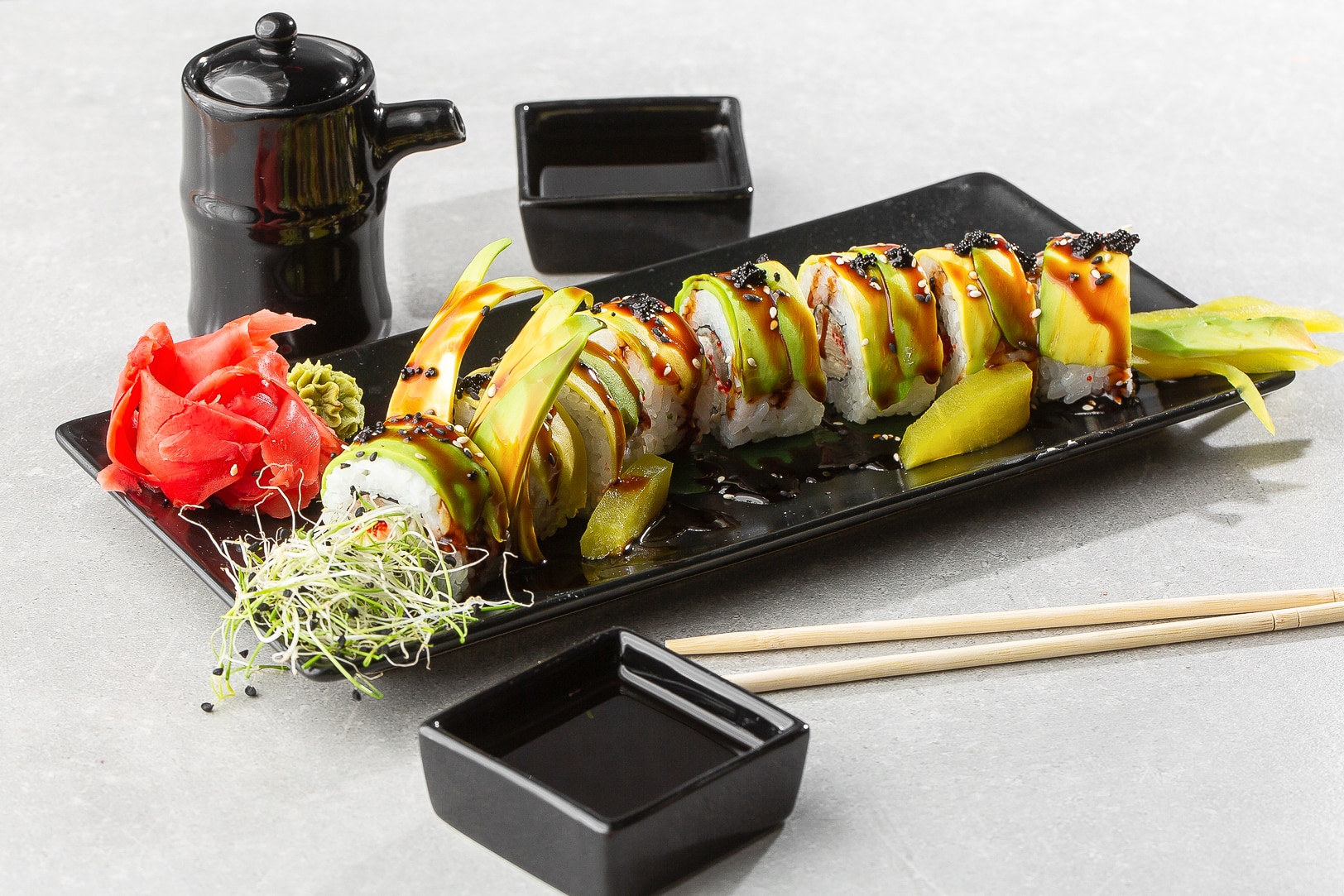
This roll truly varies chef to chef. What it has in common is avocado on the outside – the green dragon scales! Ask about ingredients and monitor your FODMAP intake.
- Crunchy Sushi Roll: Many different maki rolls will be offered with a crunchy topping, which can vary in content, so you have to ask what it is. Very often it is cooked tempura batter, but sometimes it is Japanese panko (breadcrumbs). We have even seen onion flakes! You definitely have to ask and make decisions based on your knowledge of your tolerance to FODMAPs such as fructans from the wheat in the tempura and panko, or from onions.
Is Raw Fish Safe To Eat?
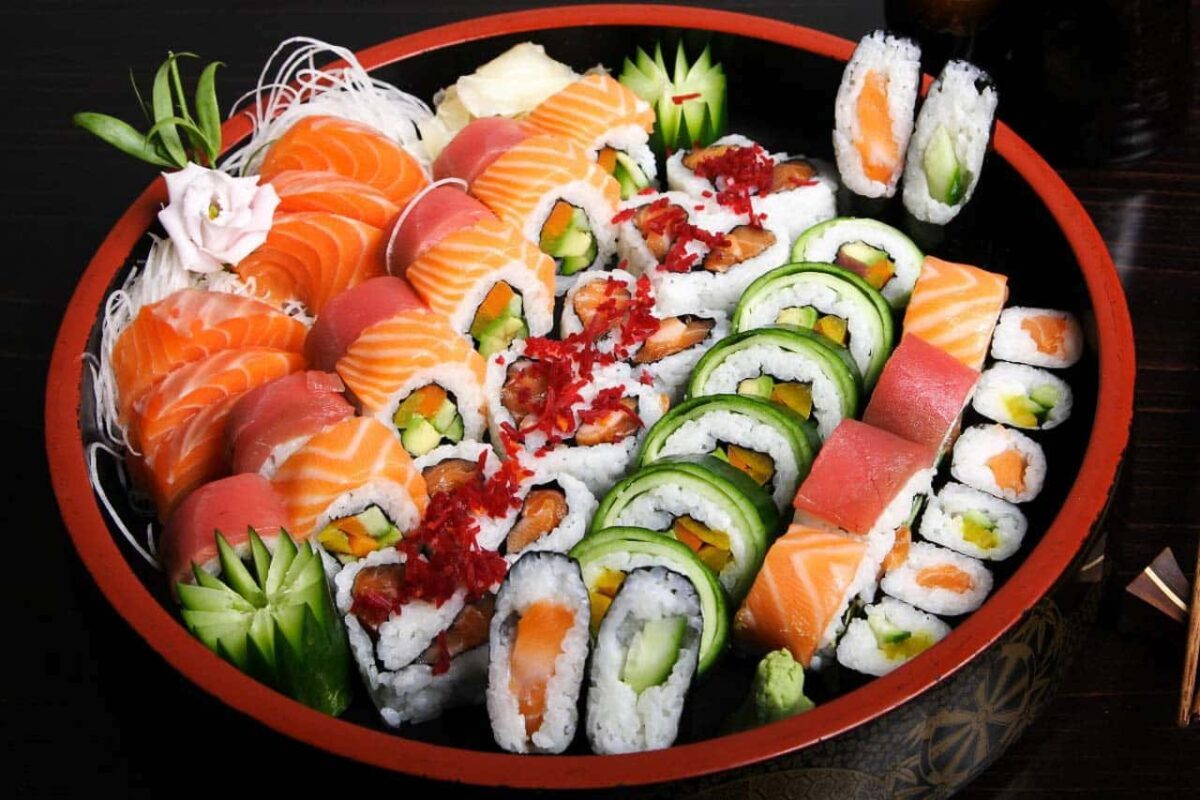
Consuming raw fish can be a safe choice for the majority of healthy individuals, provided proper safety precautions are observed. Diverse culinary traditions worldwide incorporate raw fish into their dishes, ranging from sushi to ceviche to crudo, showcasing both their aesthetic appeal and delightful flavors.
While the associated health risks are typically low for healthy individuals, they can escalate for specific populations. Common symptoms of foodborne illnesses among healthy individuals include nausea, diarrhea, fever, and abdominal discomfort. Yet, for vulnerable groups such as those aged over 65, under 5, expectant mothers, and individuals with compromised immune systems, the risks can manifest as severe and potentially life-threatening ailments.
According to aboutibs.org, a very frequent trigger for IBS is infectious gastroenteritis, commonly referred to as foodborne illness, or post-infectious IBS (PI-IBS). With PI-IBS, individuals may persistently experience gastrointestinal symptoms even after the initial infection has cleared. The digestive issues can become long term.
Discussing the consequences of PI-IBS with your gastroenterologist would be prudent, especially if you have concurrent digestive issues. On the other hand, many people who already have IBS enjoy sushi. The choice is up to you.
If eating raw fish, making sure the raw fish is appropriate for eating raw is vital. Notice that we didn’t say “fresh”, and that is because frozen fish is often used for sushi, and that is a good thing! Read on.
Contrary to Popular Belief, Frozen Sushi Fish is a Good Thing
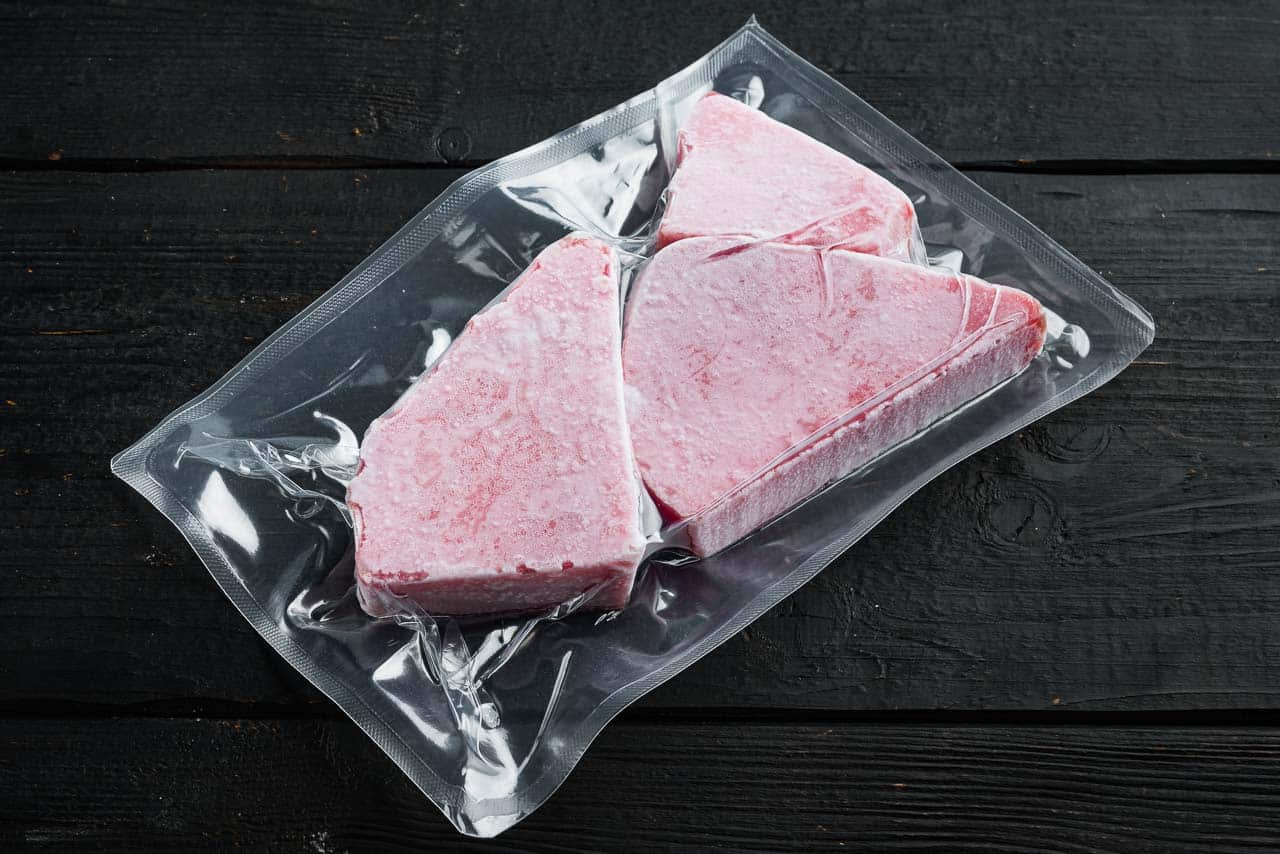
Freezing effectively eradicates parasites that pose health risks. The U.S. Food and Drug Administration (FDA) advises freezing fish at temperatures of -4°F for seven days (or -31°F for 15 hours for accelerated freezing). However, not all types of fish necessitate freezing. According to the FDA, freezing is generally unnecessary for certain tuna varieties and farmed fish raised in open water enclosures, ponds, or tanks.
Those who make sushi and sashimi are well aware of these guidelines, and we hope that they are implemented. You can certainly ask at the counter.
It is never suggested that you go to a fish counter and buy raw fish to make sushi or sashimi at home, unless the fish has specifically been labeled as sushi-grade. You can find such fish in many upscale supermarkets or specialty markets, such as Whole Foods and H-Mart.
Sushi From Supermarkets
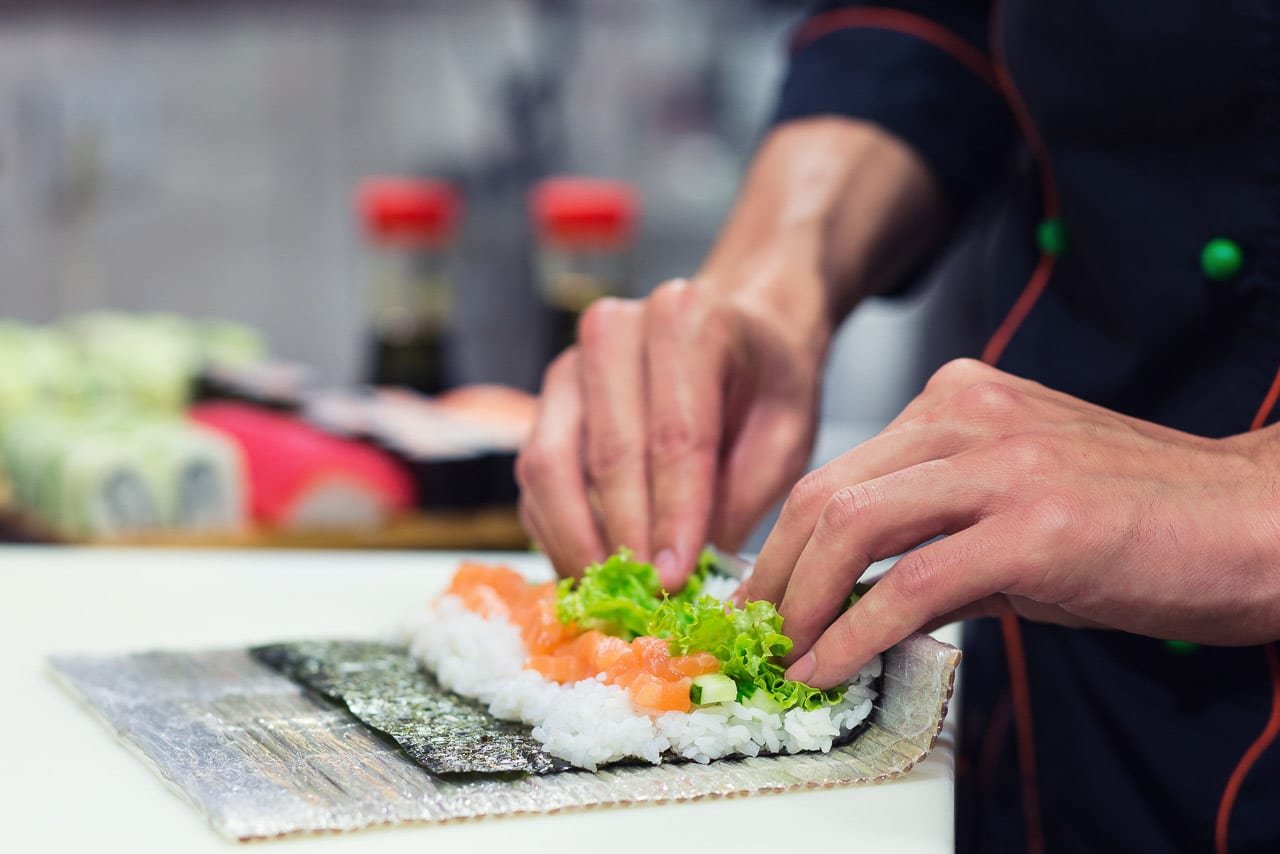
Have you noticed whether your local supermarket chains have a sushi counter? It is mostly chains that offer it, although a few independent stores do, too, and the quality can vary.
Chains in the U.S. that have sushi counters include Kroger’s Albertson’s, The Fresh Market, Whole Foods, Wegmans, Sprouts Farmers Market, Gelson’s, Publix, H-Mart – and Costco.
We love this quote from Reddit about Costco: “I never thought I would enjoy sushi from the same place I buy my tires, but wow! This is super fresh and really delicious. Also, very fun to watch them making it.”
And here’s a tip: All Publix locations that offer sushi participate in “$5 Sushi Wednesday”.
The Most Common Supermarket Sushi
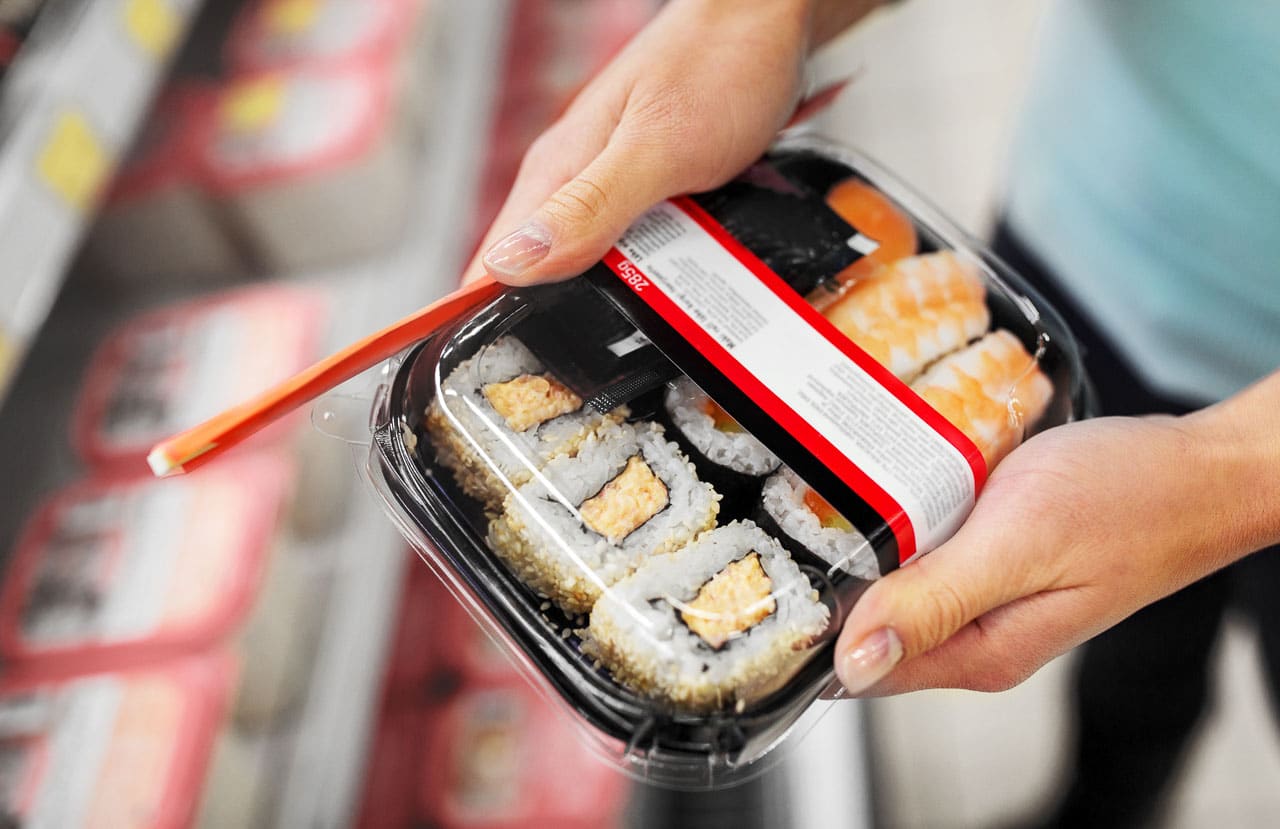
The most common types of sushi found in supermarkets are nigirizushi, and makizushi. Some markets also offer “bowls”, or chirashizushi, along with inarizushi, and sashimi.
Who Makes Supermarket Sushi?
Kroger, which sells more sushi than any other U.S. supermarket outlet, works with Snowfox and Yummi Sushi, two franchisers that ensure sourcing of high grade fresh fish and run the sushi departments. Snowfox has 1300 chefs working across the nation for Kroger specifically.
Genji Sushi operates in many grocery stores. Some others are Hissho Sushi, Bento Sushi, and Sushi Avenue, to name just a few. Some supermarkets will make it clear with signage where the sushi is coming from, while others do not.
According to TopFranchise.com, Advanced Fresh Concepts Corp. (AFC) is the largest sushi bar franchisor in US supermarkets. They have over 4,000 stores and their sushi is made fresh in-store daily throughout its franchise locations at grocery stores across the United States, Canada, and Australia.
Even when a supermarket might have their own chefs and make sushi in-house, they might be partnering with a company such as AFC to provide the ingredients.
Is Supermarket Sushi Less Expensive?

On average, restaurant sushi is about 50 cents more per roll, than supermarket sushi. This was when studies looked at tuna avocado rolls.
What About Supermarket Sushi Quality?

Sushi lovers want to know about the quality of supermarket sushi. There is no black and white answer.
At supermarkets where they are buying and selling pre-made containers of sushi, that was made off-site, there is a distinct degradation of sensory experience (taste and texture), even if the sushi started with quality ingredients. Any sushi that has been sitting around will not be great.
Which brings us to the nuance of the situations where you have sushi being made in-house. If you can make a request, and it is made for you right then and there, and you eat it soon after, the quality can be quite good – and even as good as some restaurants.
If the sushi was made in house, but then has sat in the grab-and-go refrigerator case for a while, it will not be as good, but still better than the first instance, where it was made off-site.
The raw fish, if used, is still safe to eat, even with those that have sat around a bit, assuming the fish was appropriate for raw consumption in the first place.
We find the biggest challenge is with the rice. Sushi rice (any cooked rice, really) that has been refrigerated will not be an optimal experience. The longer it is chilled, the firmer it gets, and the texture really suffers. Freshly made and eaten sushi rice has a delectable quality. Refrigerated rice does not. So, it might come down to how picky you are about that.
Then of course, how well was the sushi made in general? Was a high quality wasabi, soy sauce, and pickled ginger offered? These can vary hugely. And how was the quality of the proteins, especially the raw fish?
Sushi & Sashimi Etiquette
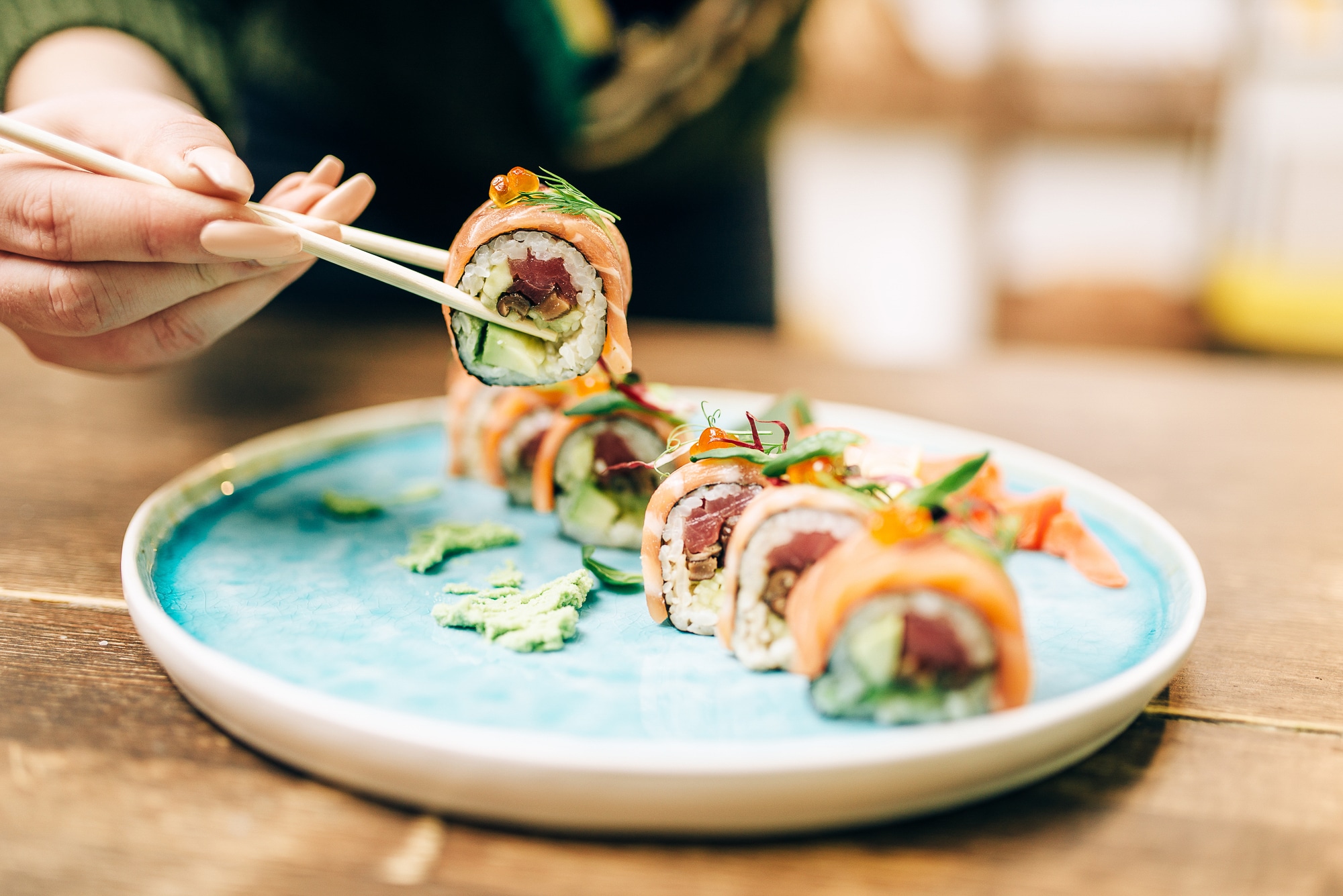
Often when you sit down to eat sushi in better restaurants, you are presented with a warm, wet washcloth with which to wipe your hands. Not only is this a gracious way to start, but if you are eating the sushi with your fingers, which is perfectly OK, it is sanitary as well.
Here are some etiquette rules to remember:
- Every place setting should have a small dipping dish (for soy sauce) and a pair of chopsticks.
- There should be a small bottle with soy sauce on the table. Some restaurants make a house sauce by combining soy sauce, mirin, sake and bonito flakes, but you can just use soy sauce.
- Pour some soy sauce or dipping sauce into your own dipping dish.
- A serving of nigirizushi (fingers of rice covered with topping) usually contains two pieces of each kind.
- Pick up each piece of nigirizushi with chopsticks or your fingers and dip the topping in soy sauce in your little dish. That’s right! You are going in fish first! If you dip the side with the rice, it will fall apart.
- It is most proper to eat your nigirizushi in one bite – two at the most.
- When eating sushi rolls, you can use chopsticks or your fingers. Hand rolls are always eaten out of hand.
- There will be wasabi and pickled ginger offered with your sushi and sashimi. Add a dab of wasabi to your sushi and sashimi to taste and eat pickled ginger between bites of sushi to cleanse the palate.
- Sashimi will often be presented with a mound of finely shredded daikon; eat it between pieces of fish to refresh your palate.
- And remember, when it is time to take a break, place your chopsticks horizontally in front of you, parallel to the edge of the table that is closest to you.
The Takeaway
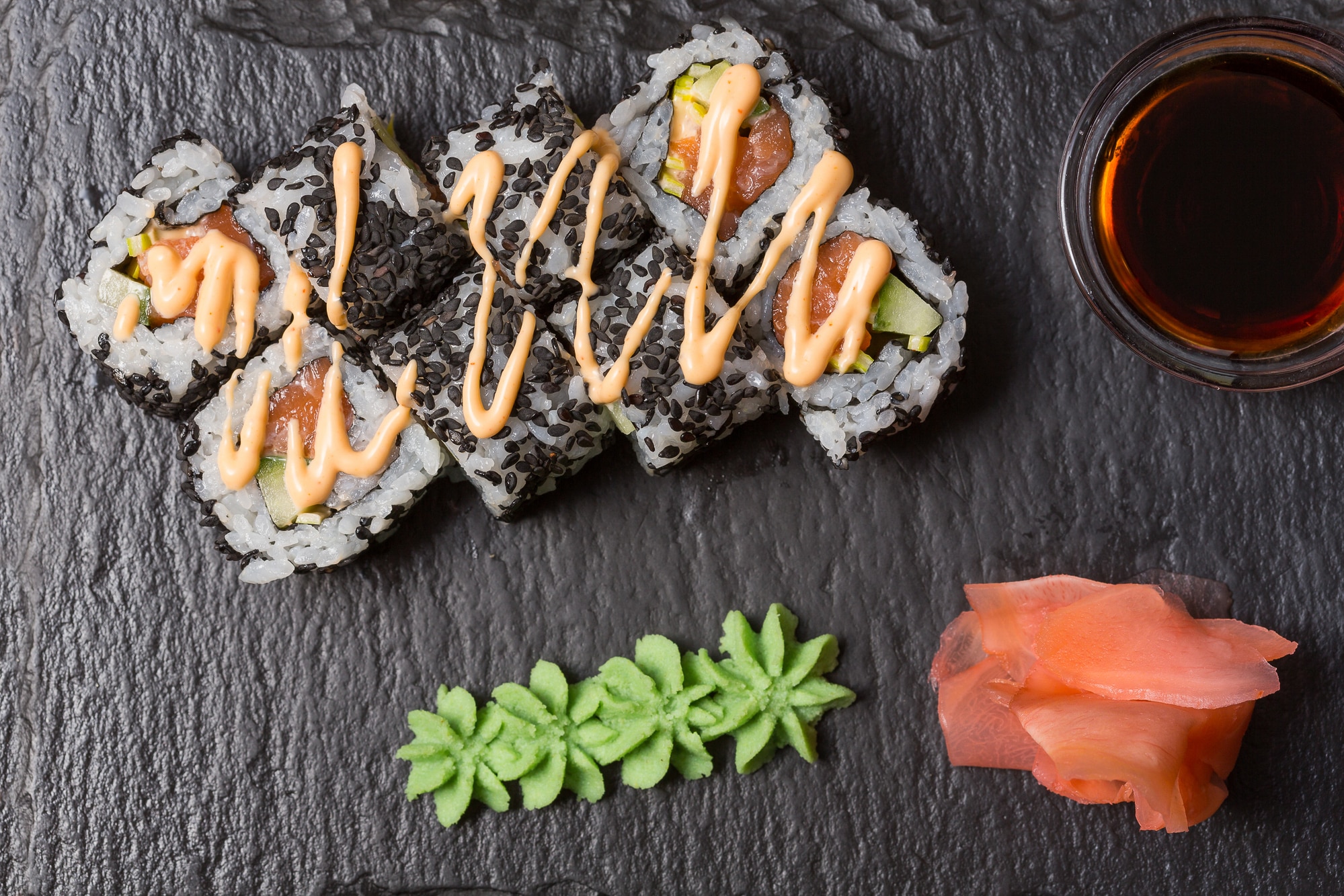
You absolutely can enjoy sushi while following the low FODMAP diet – even during the Elimination Phase. Raw fish, such as sashimi, contains no FODMAPs at all. Sushi rice, along with nori, pickled ginger, wasabi, miso soup, and other common foods found on sushi menus, all have low FODMAP serving sizes.
We find that when going out to eat, choosing a Japanese restaurant is a great low FODMAP choice! Just use this guide above to help you make smart, low FODMAP choices. You will not go hungry! Itadakimasu!
Click here to learn how to say “Bon Appetit” in Japanese!
About FODMAP Everyday
Low FODMAP Recipes Created Just For You!
Use Our Exclusive Recipe Filter To Find The Low FODMAP Recipe You Are Looking For Today!
We take low FODMAP recipes seriously at FODMAP Everyday®. That’s why Dédé oversees our Test Kitchen and makes sure that each and every recipe works. We base our recipes on the lab test results of ingredients from Monash University and FODMAP Friendly that are available at the time of initial publication. You can use any of the lab tested findings, new or older, from either Monash University or FODMAP Friendly as a baseline from which to begin to explore your relationship with FODMAPs, which will be unique.
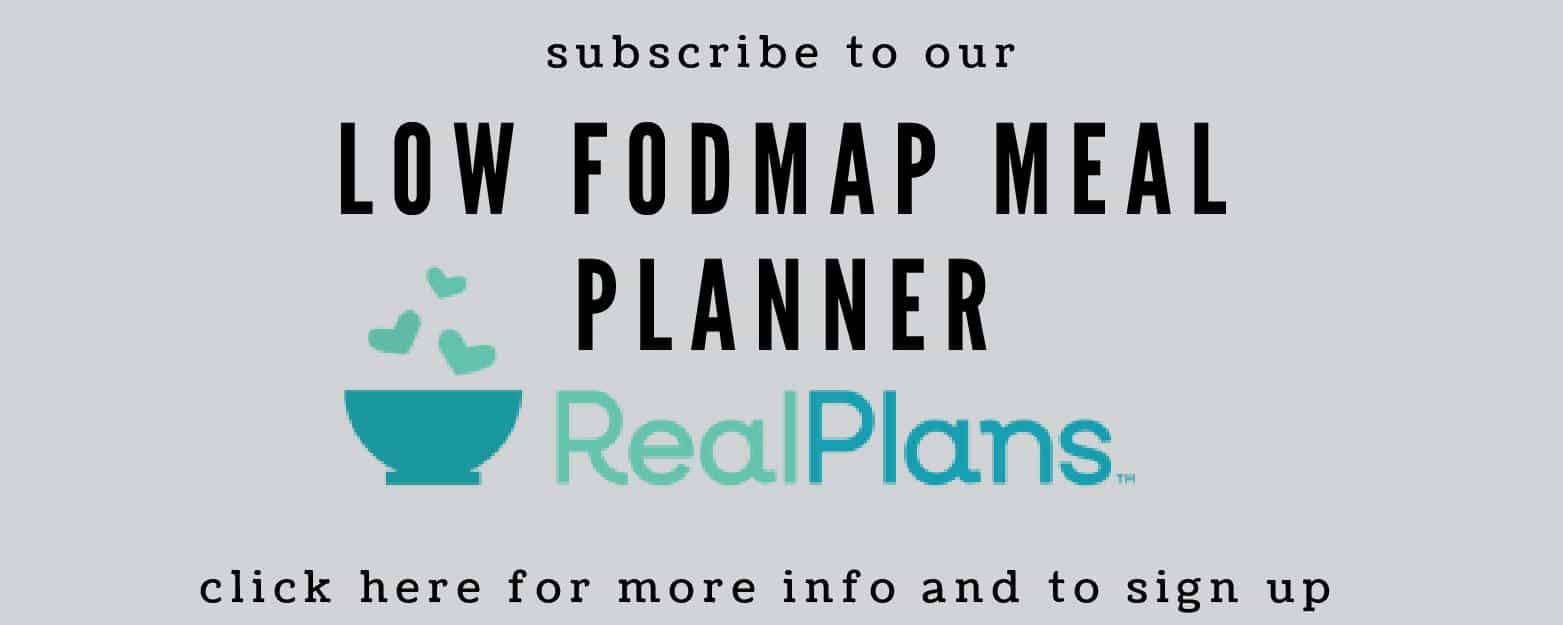
Read our article How Are Low FODMAP Recipes Created? for more in-depth information.
Rest assured that you will not find more trustworthy or delicious low FODMAP recipes anywhere – 900+ and counting. Have questions about a recipe, or did you make a recipe? We’d love to see it.
Need a break from cooking? Wish you could just order a delicious low FODMAP certified meal and heat and eat? Well you can! And you can even order some of our very own meals over on Modify Health! And if you use our discount code you can get 4 meals for FREE! See details below.
And download Fig the low FODMAP supermarket shopping app and get 15% off of Fig+ when you use FE15 at check out.

Come Join Our Low FODMAP Recipe Community! Sign Up For Our Newsletter For All The Latest Recipes and Articles.
Have questions or comments about an article – comment below. We respond quickly & love hearing from you!
Join us on









